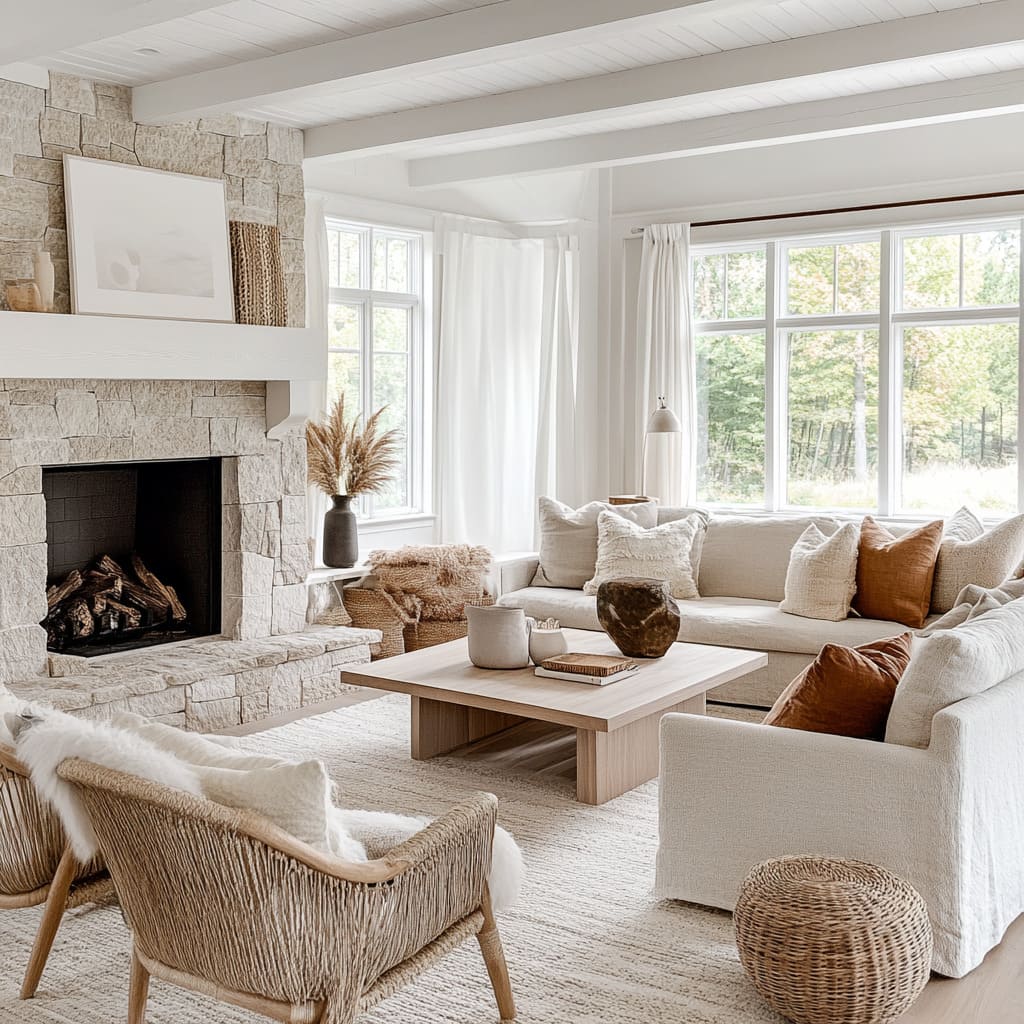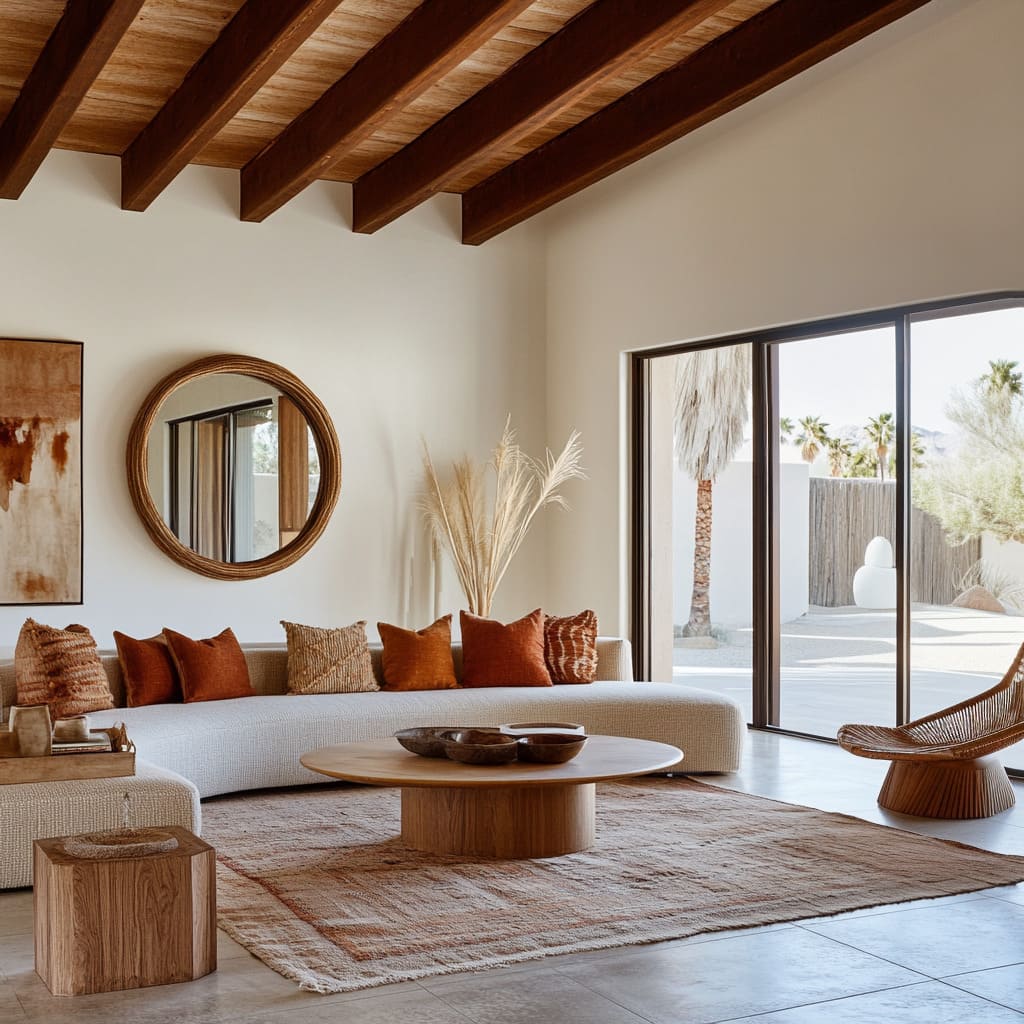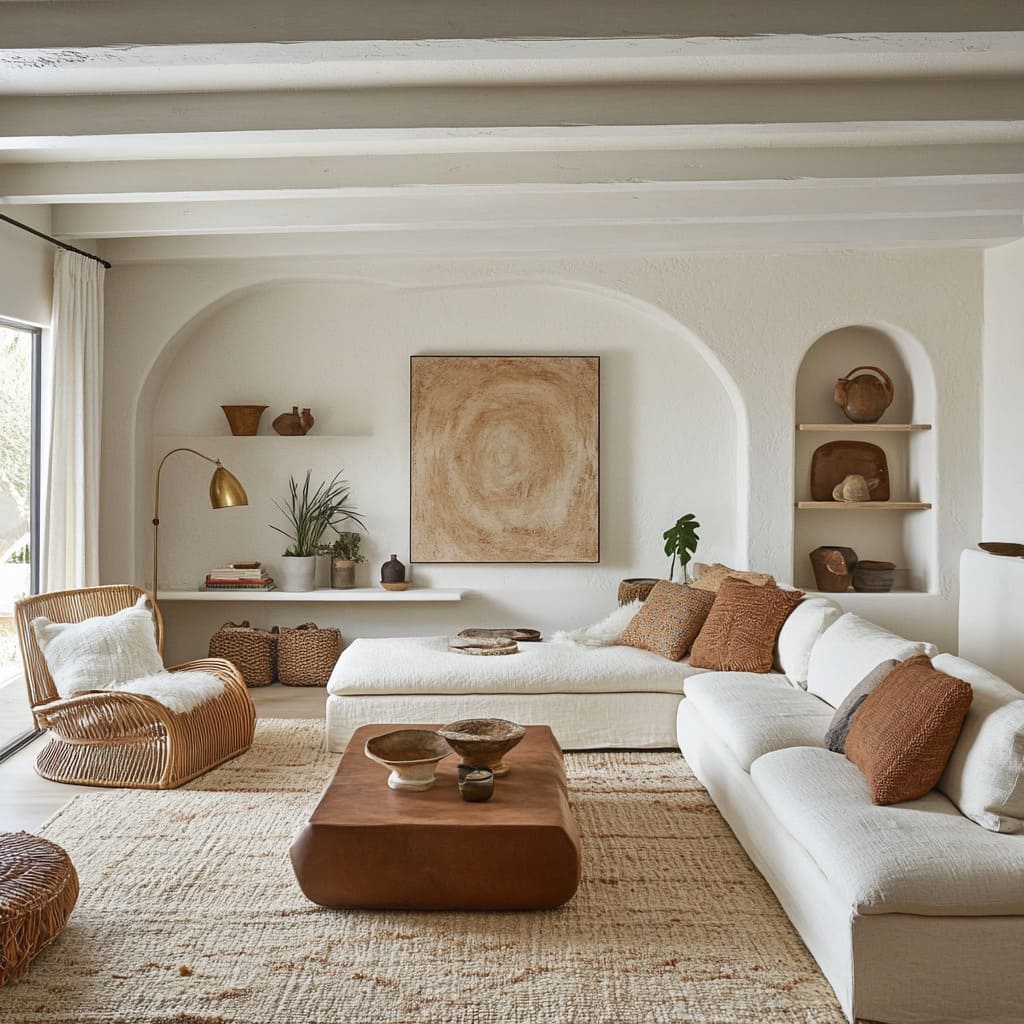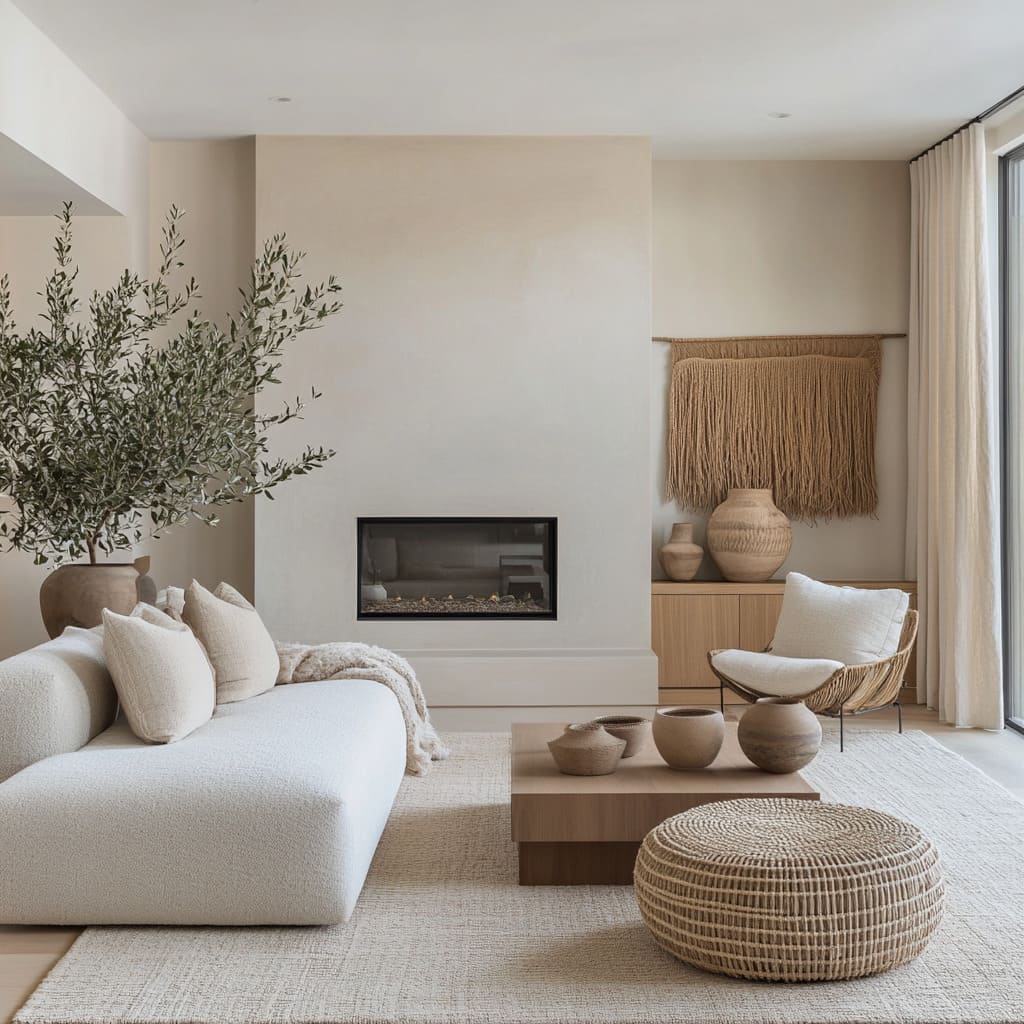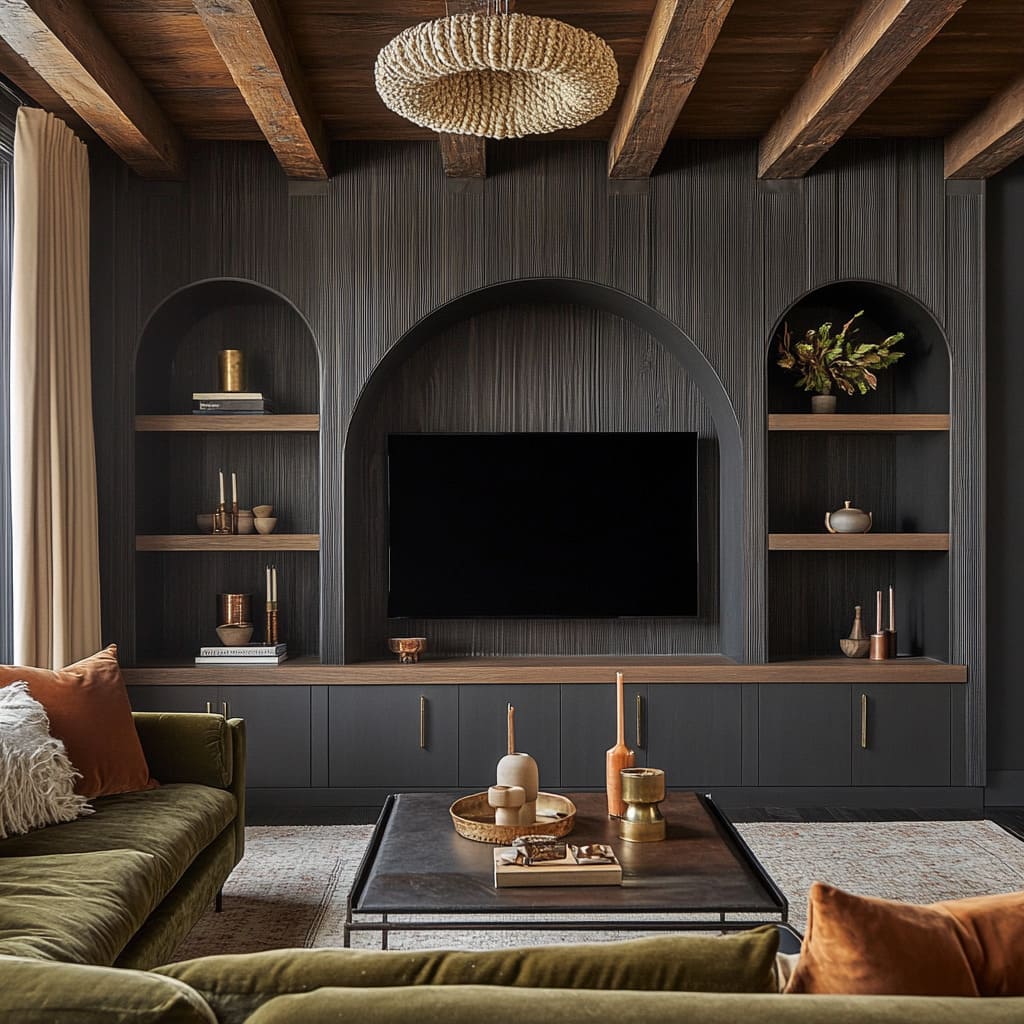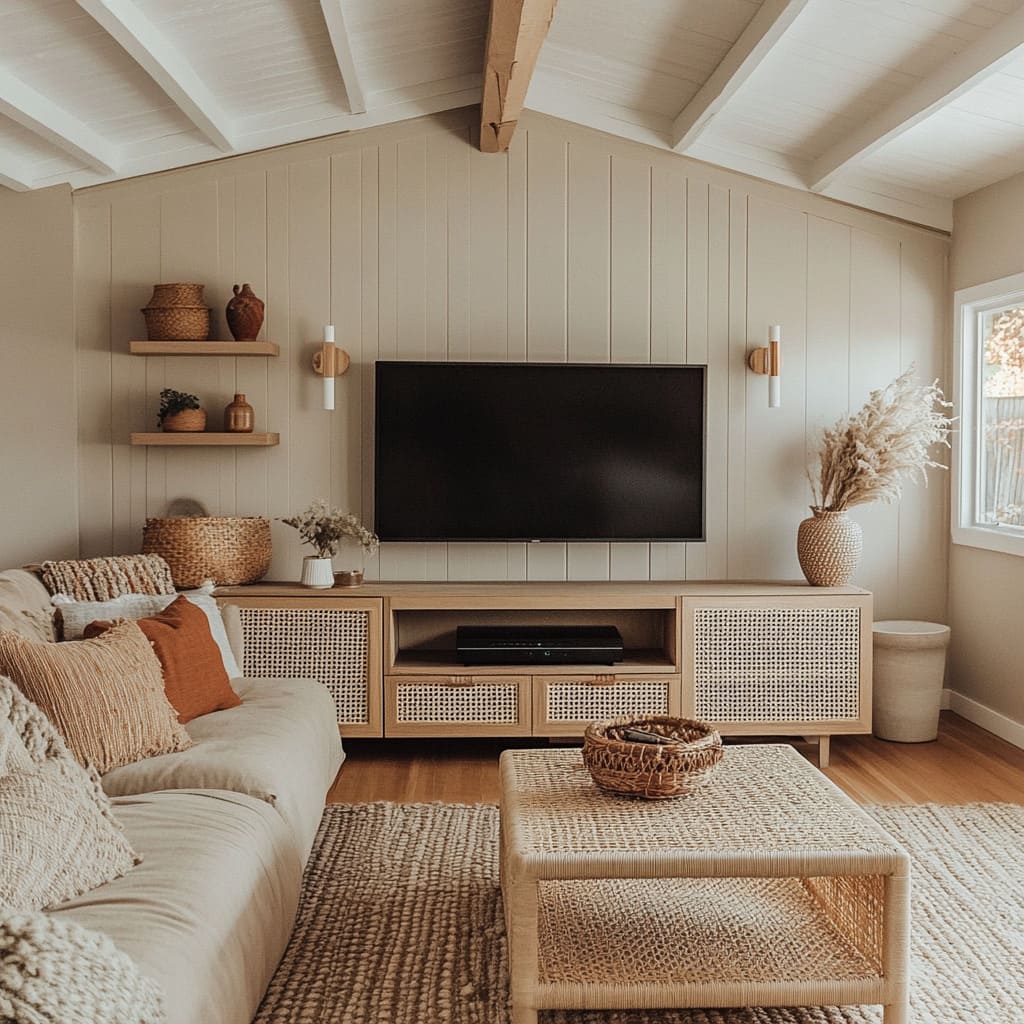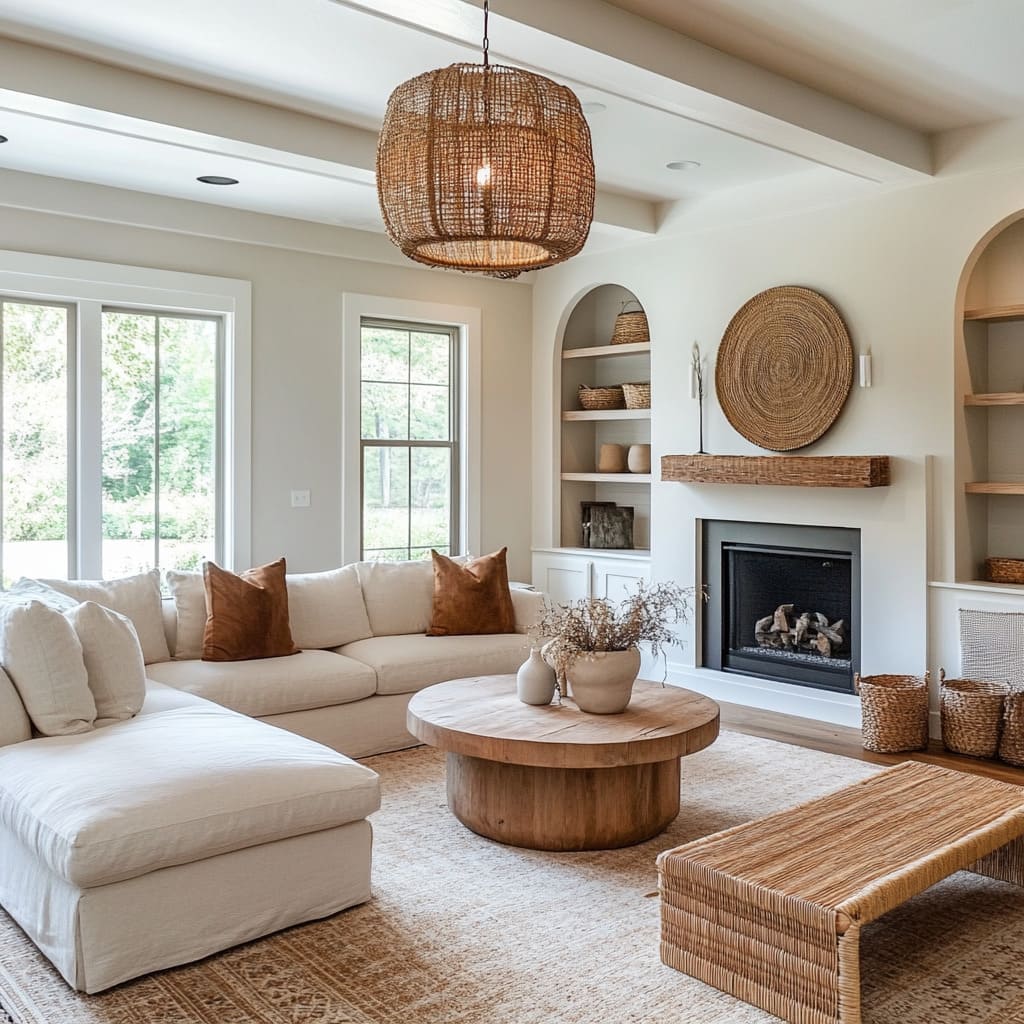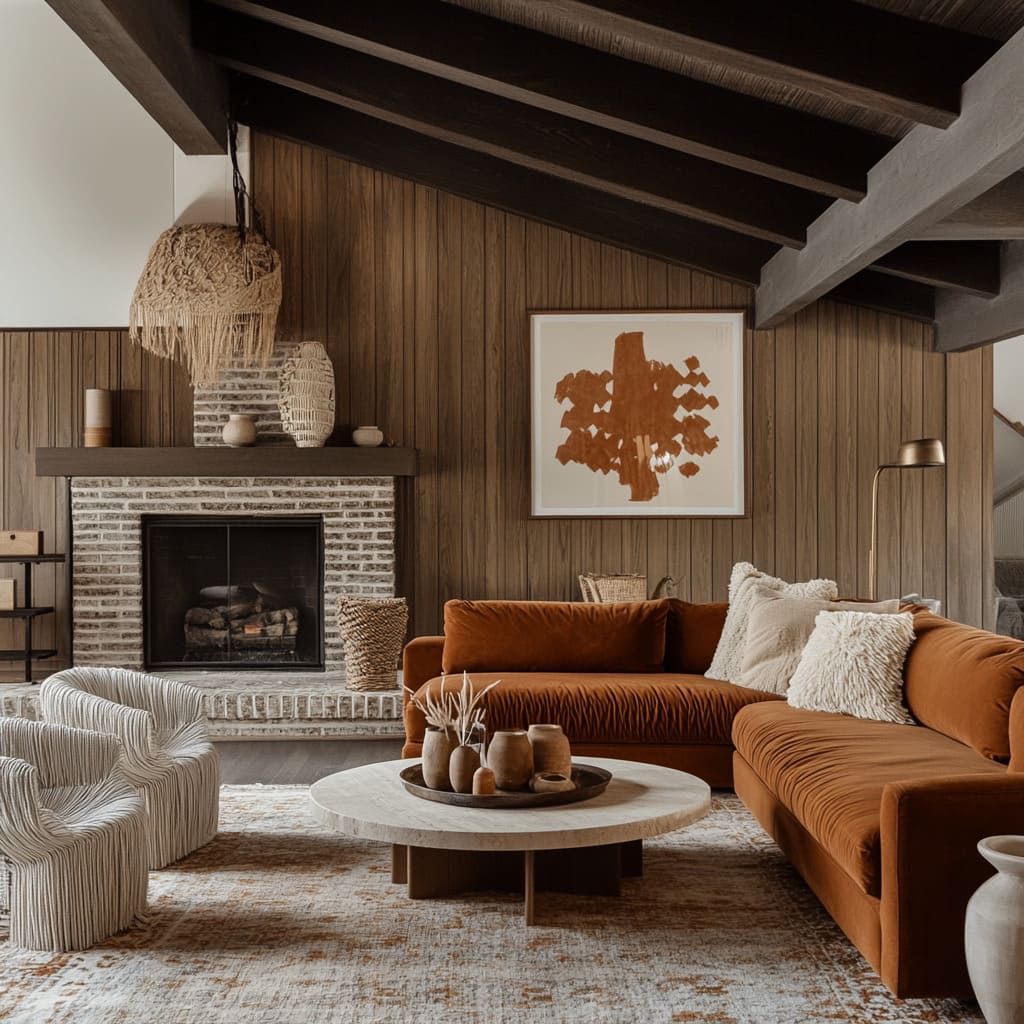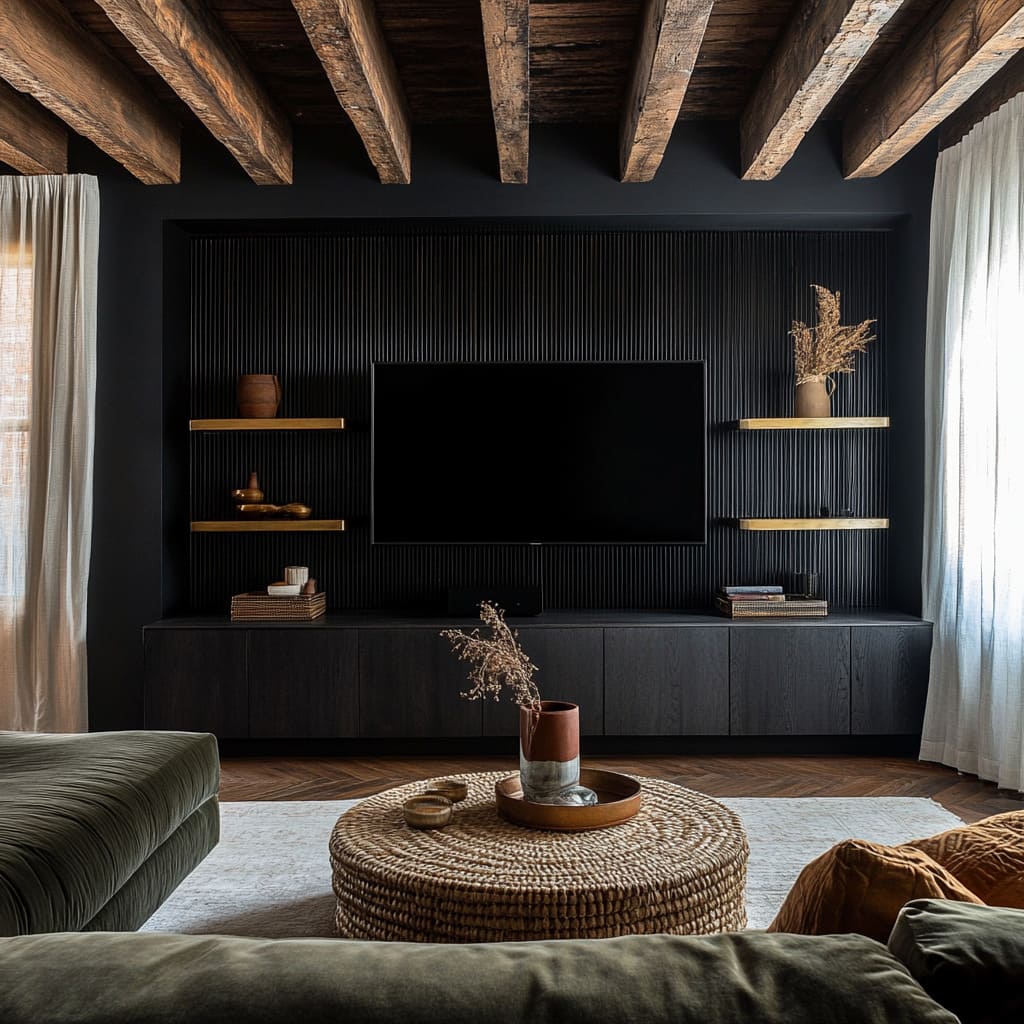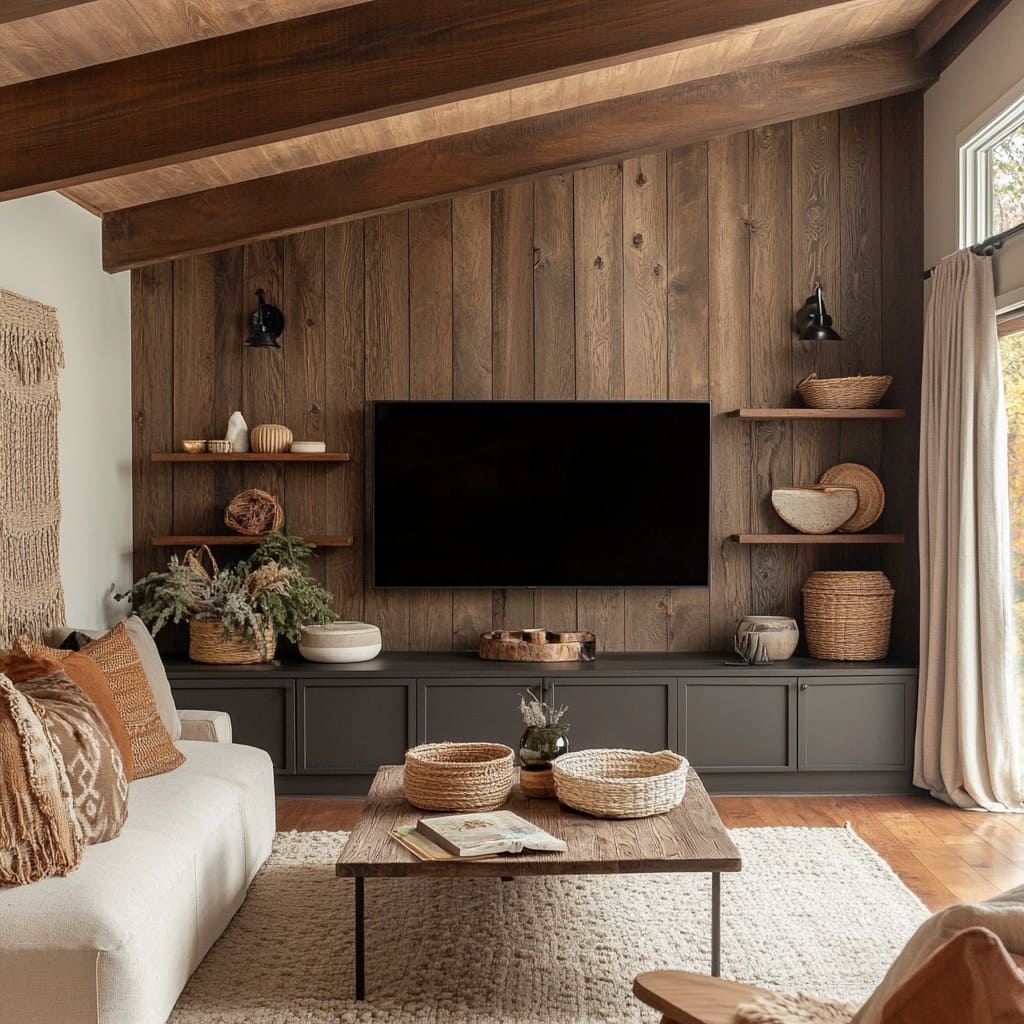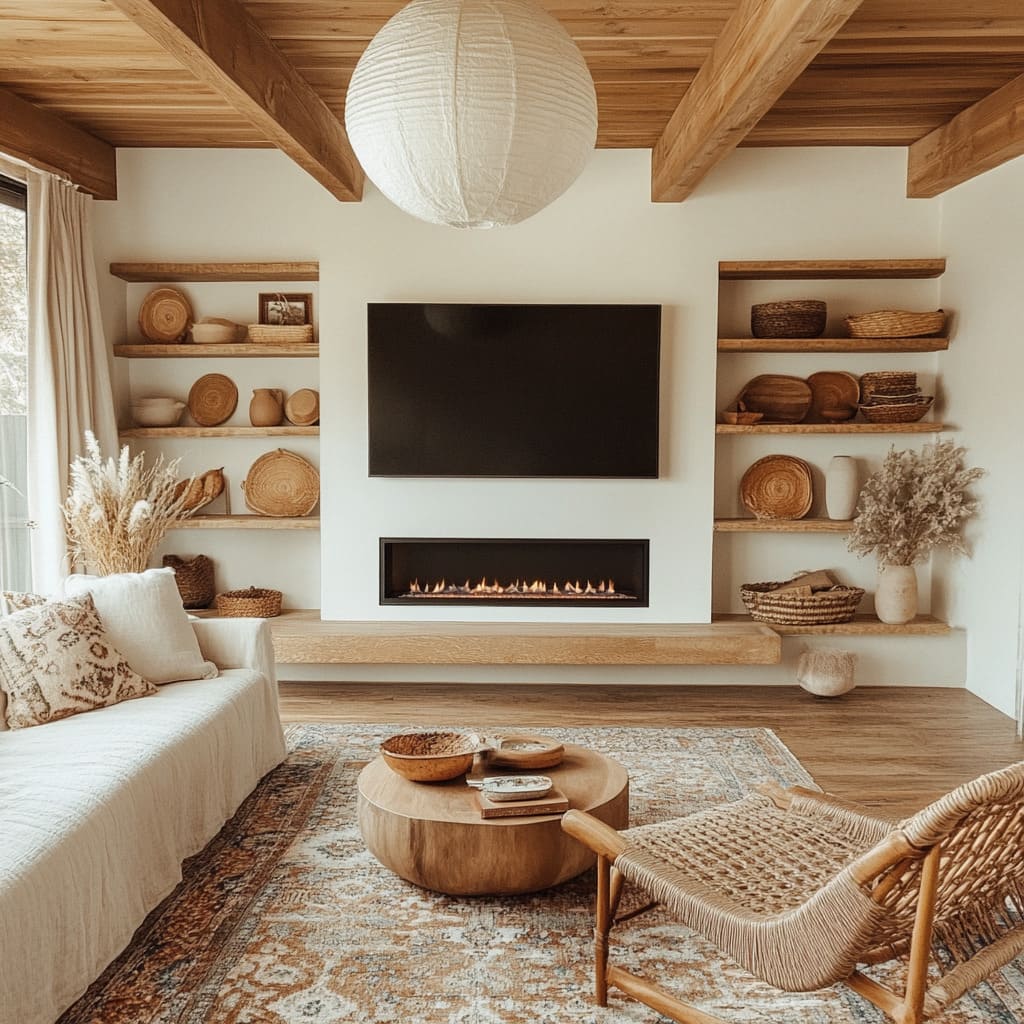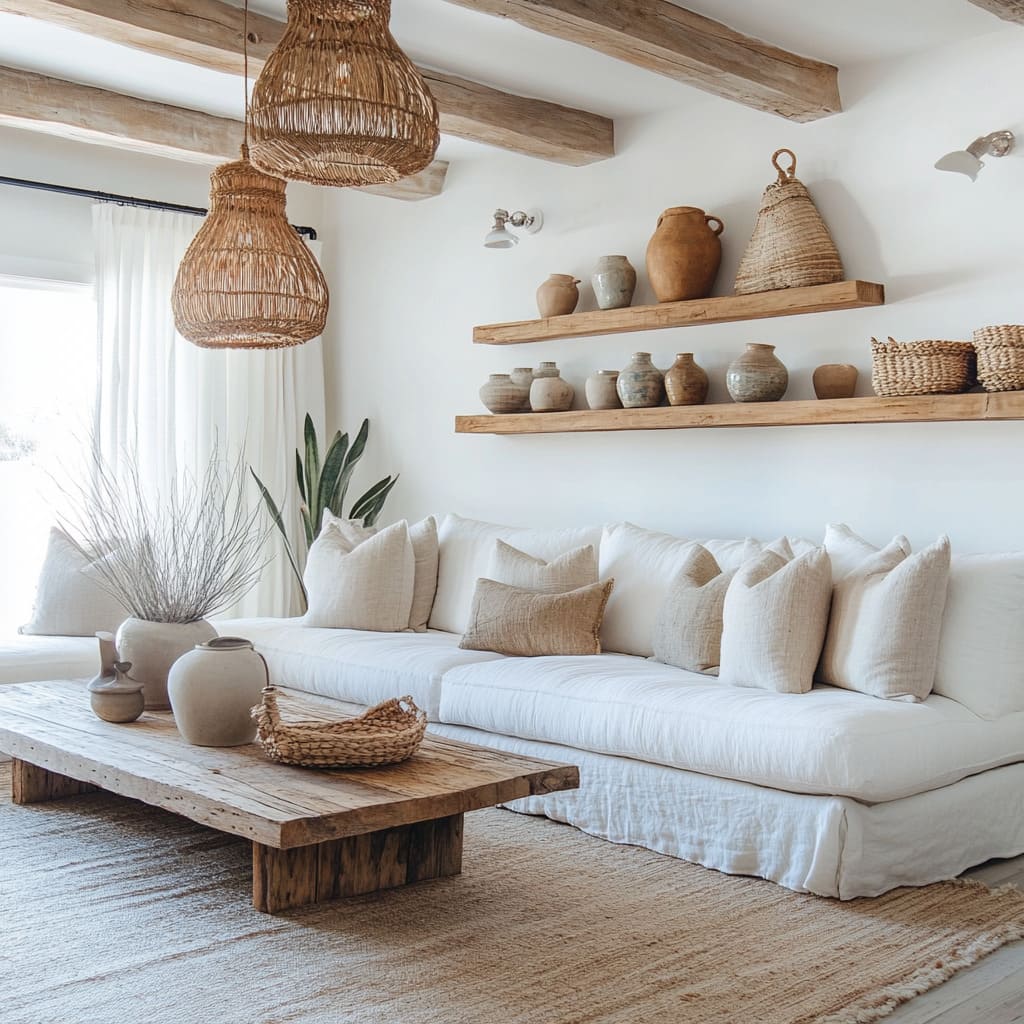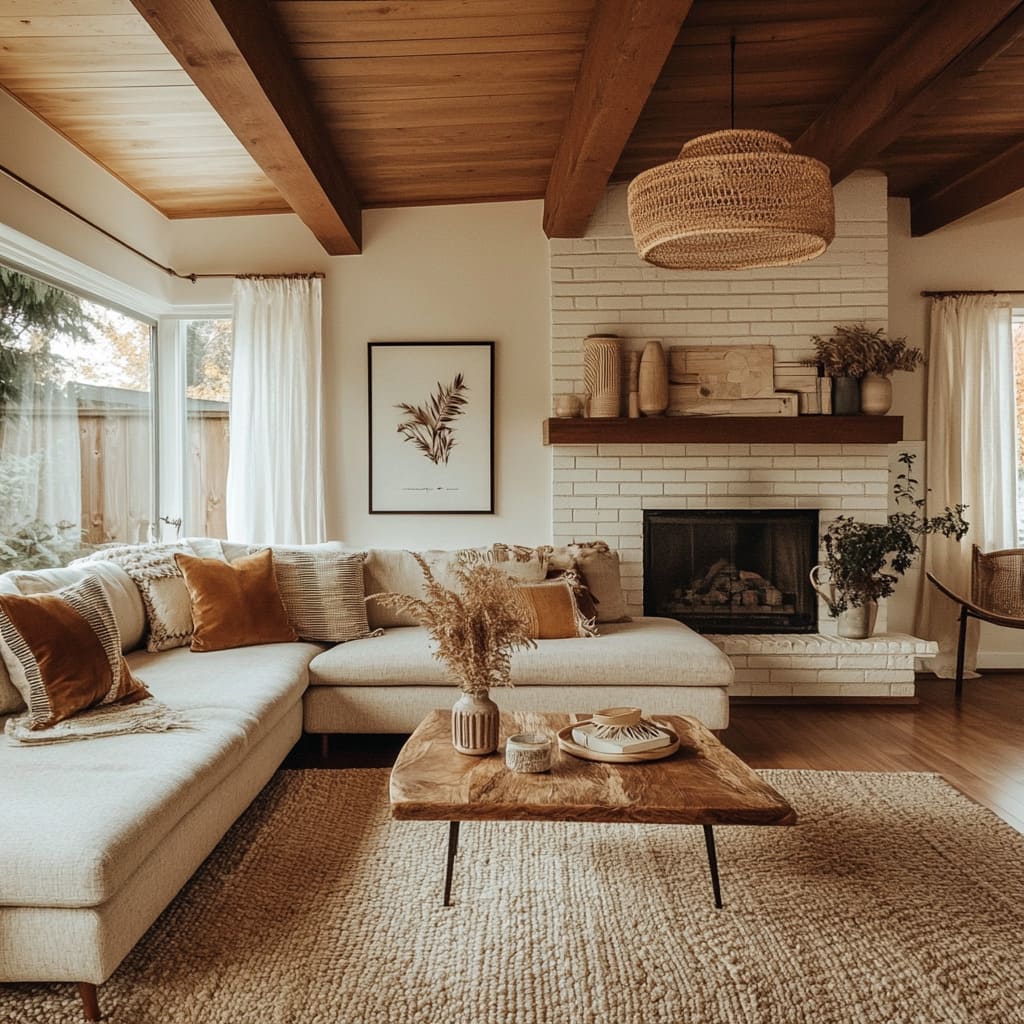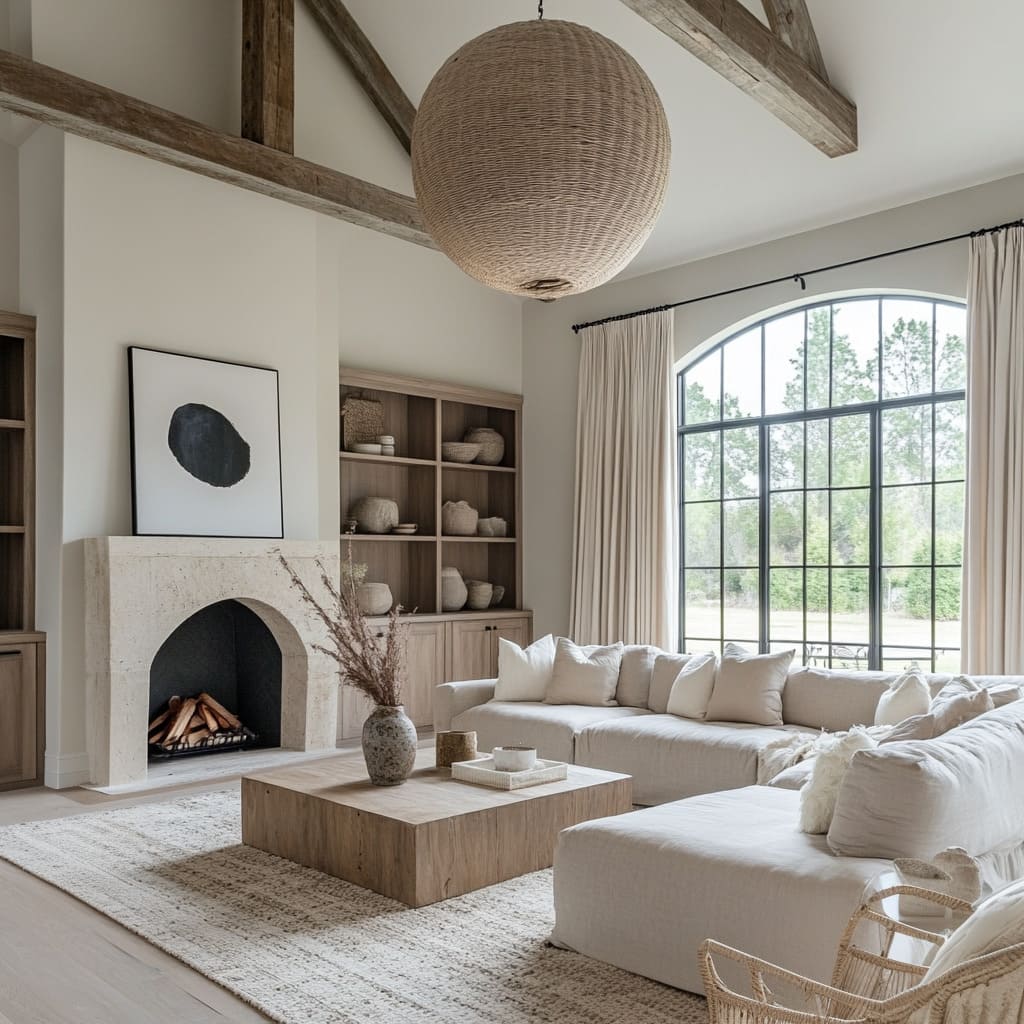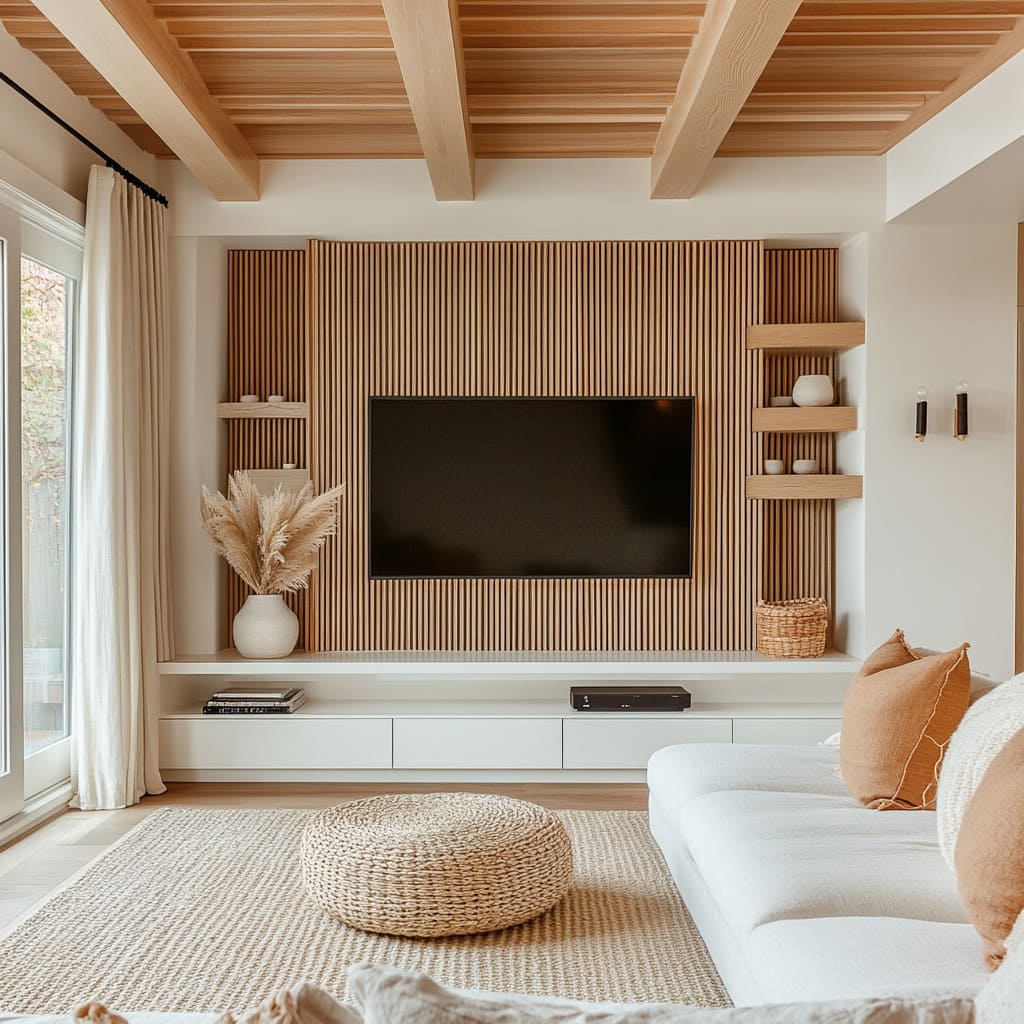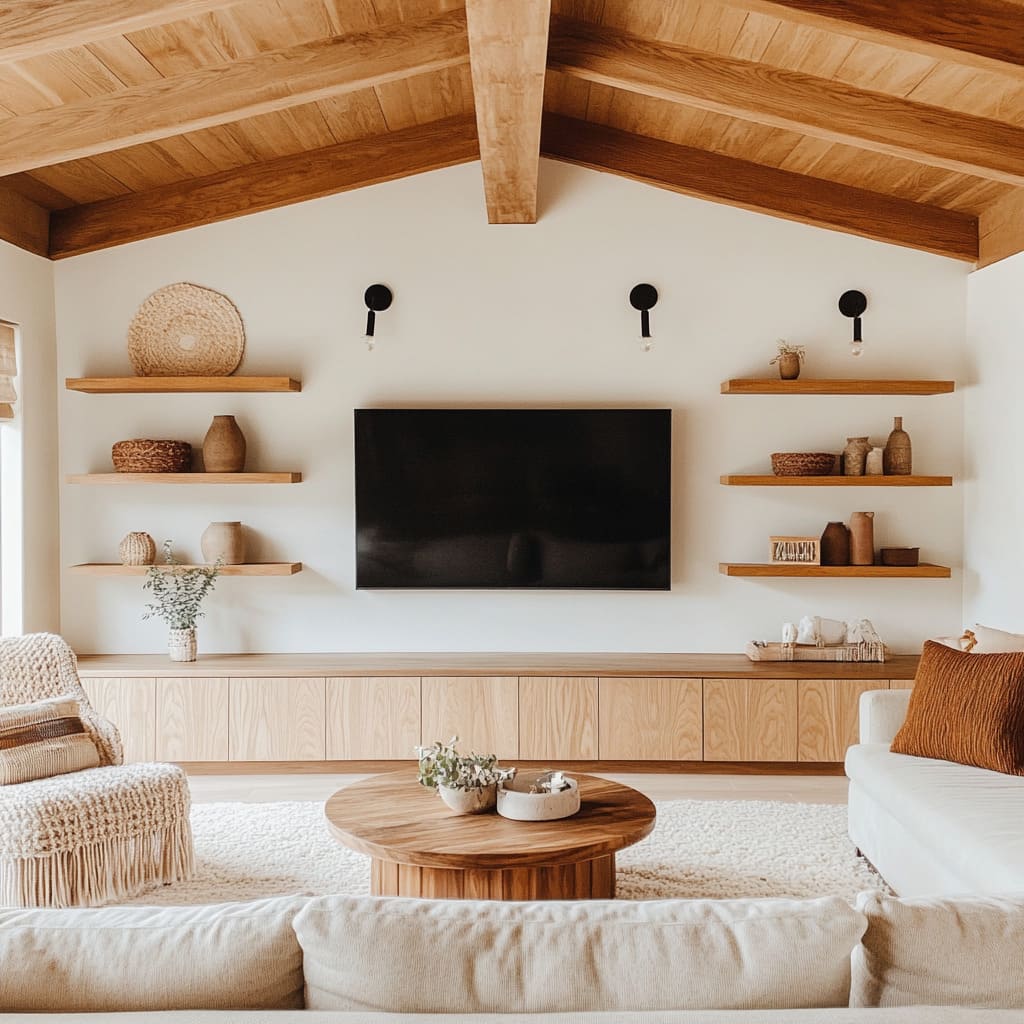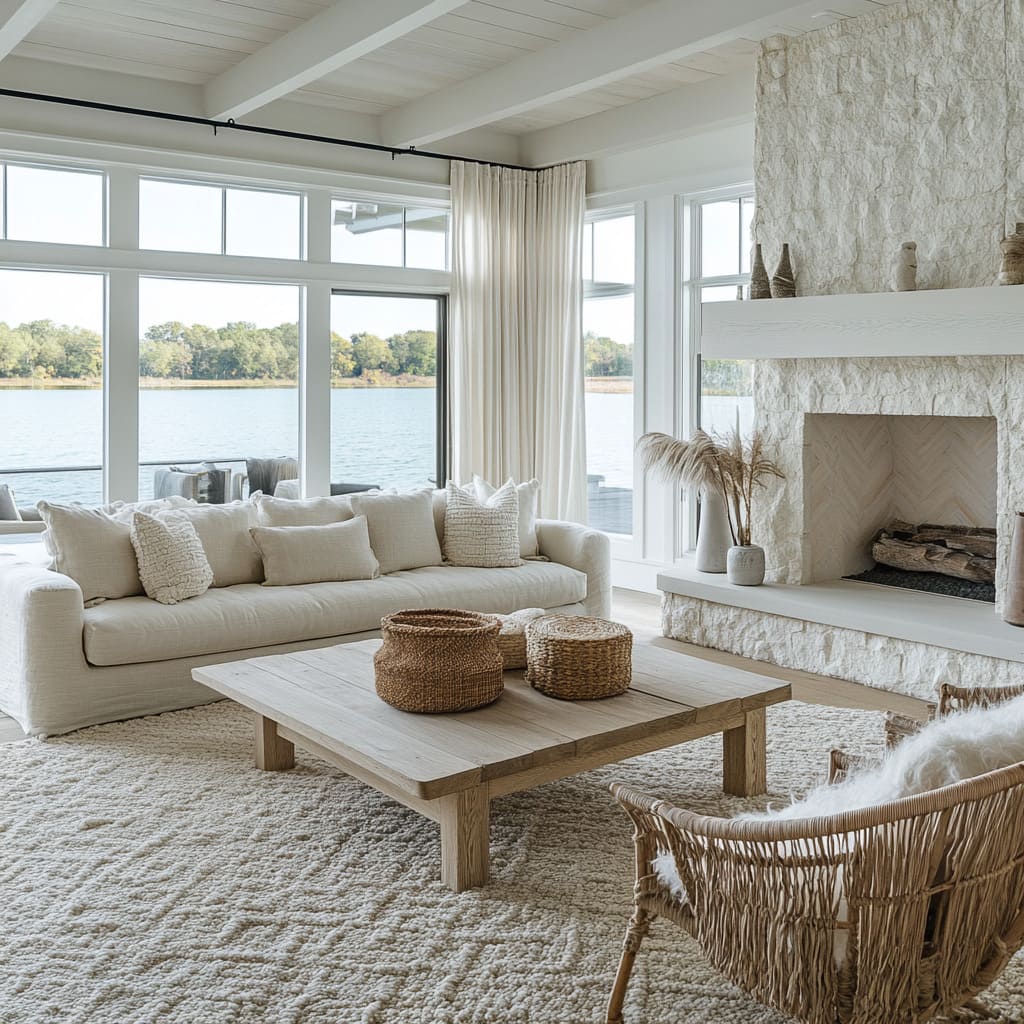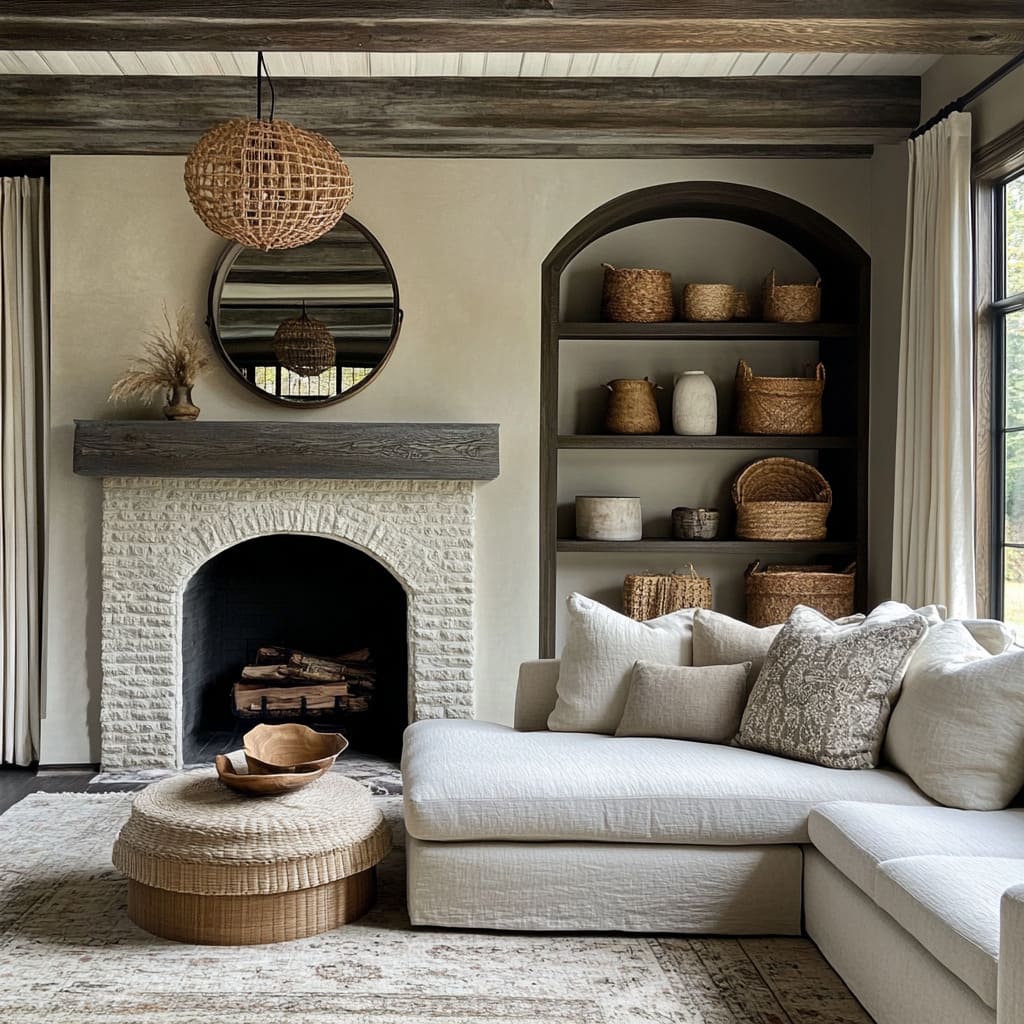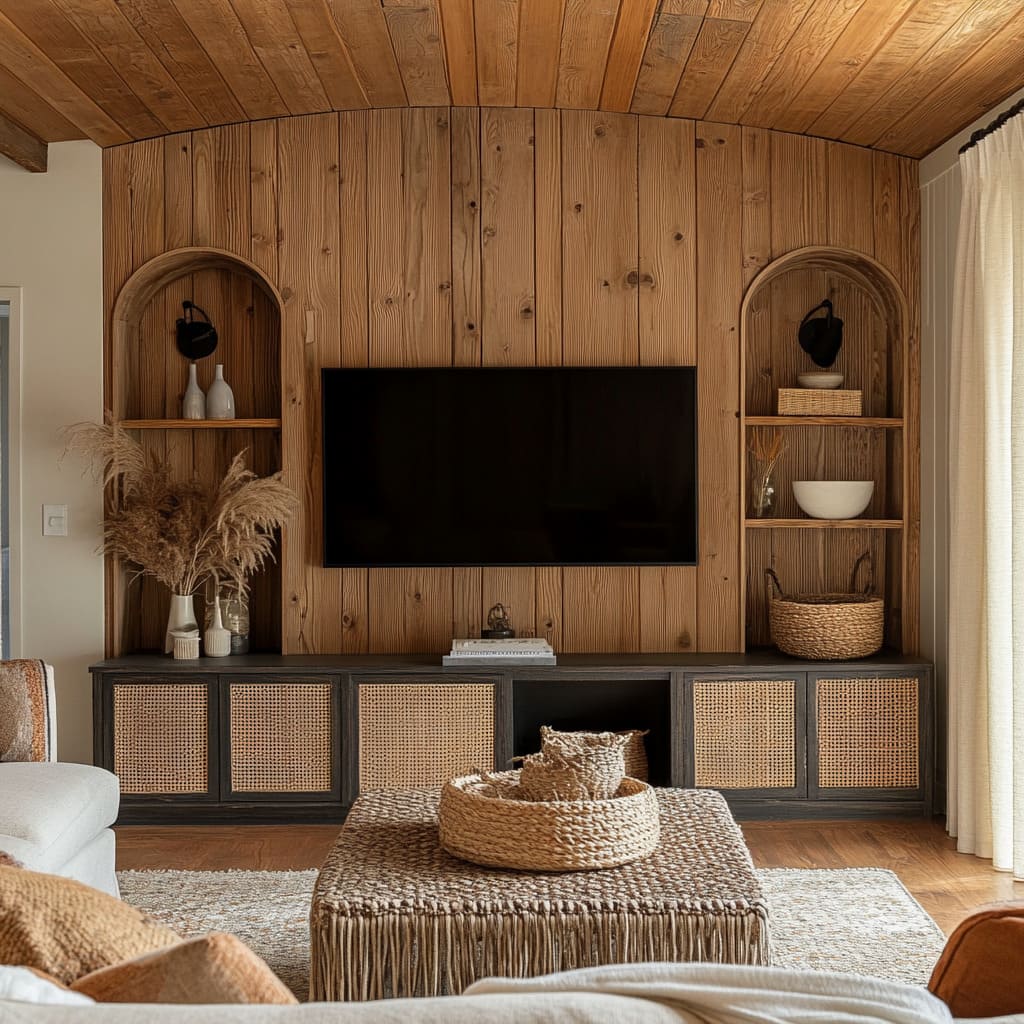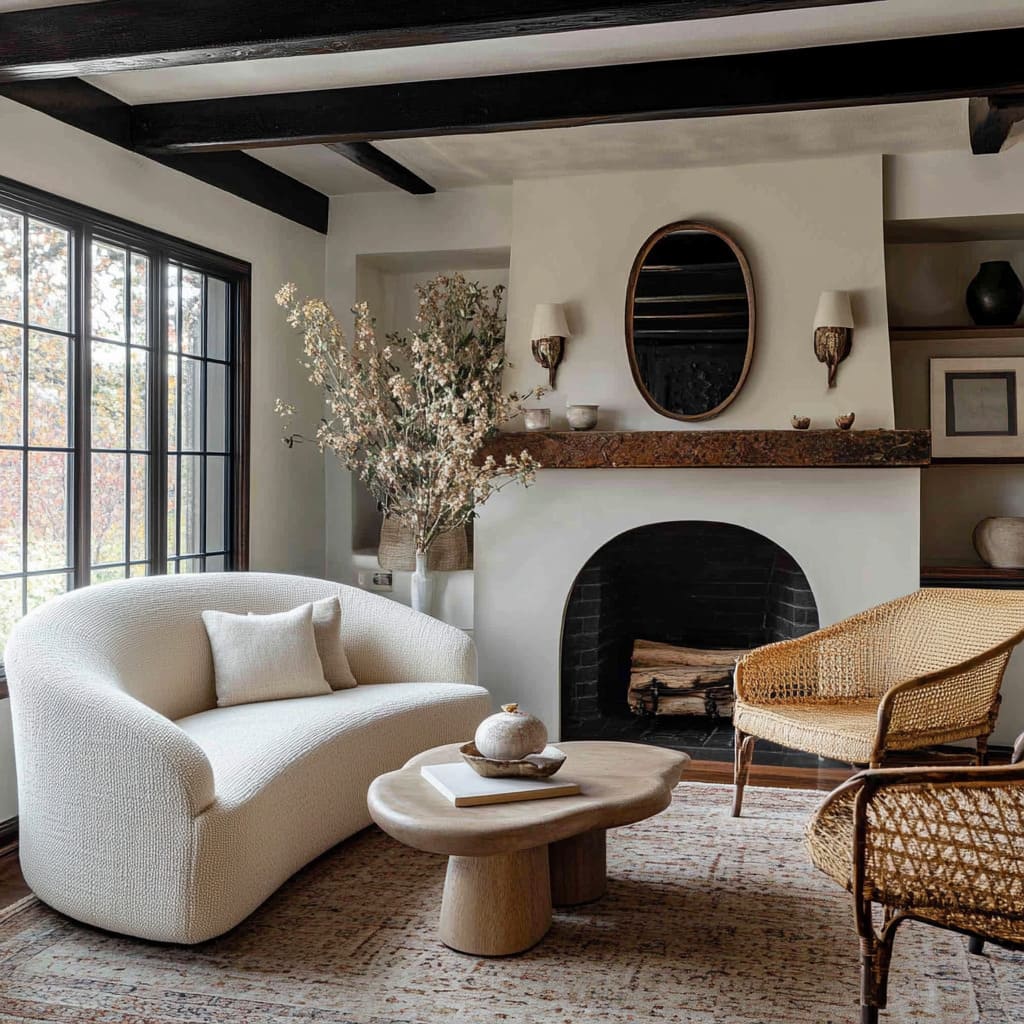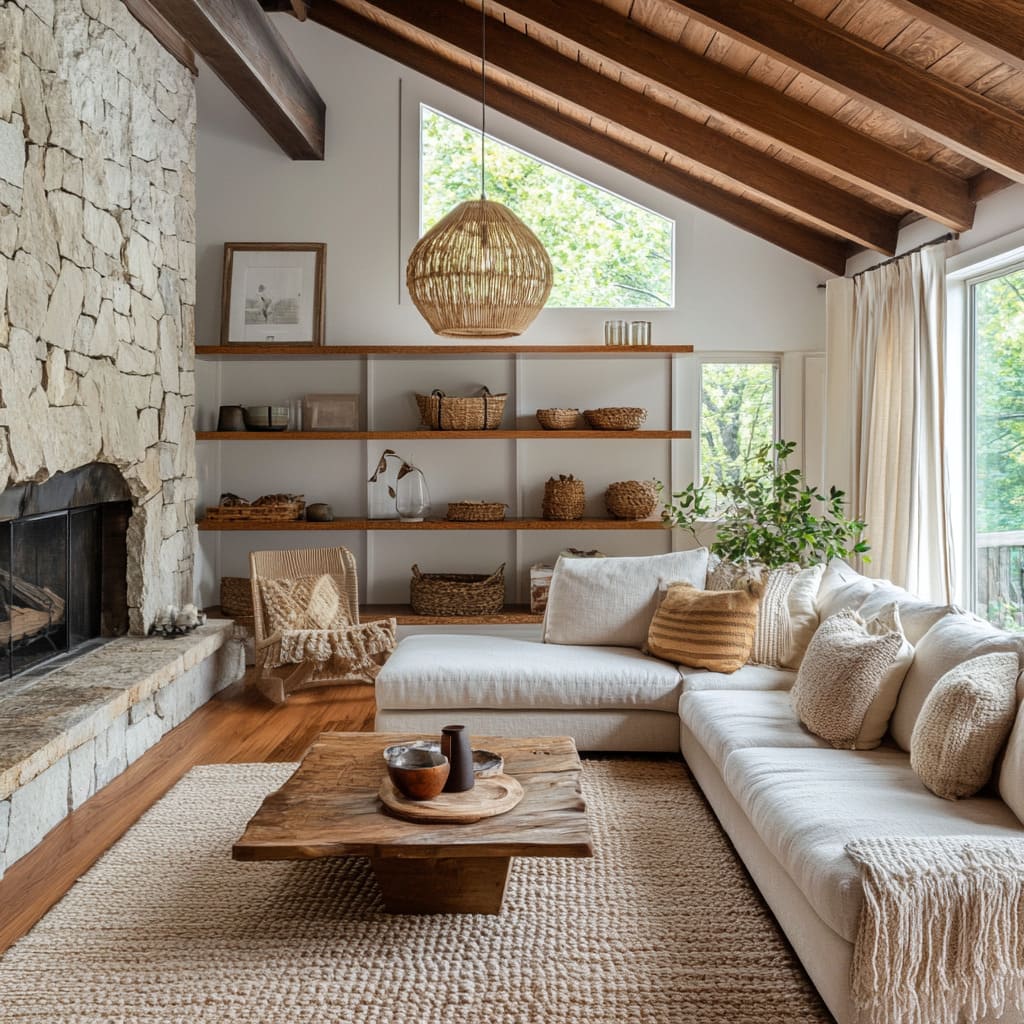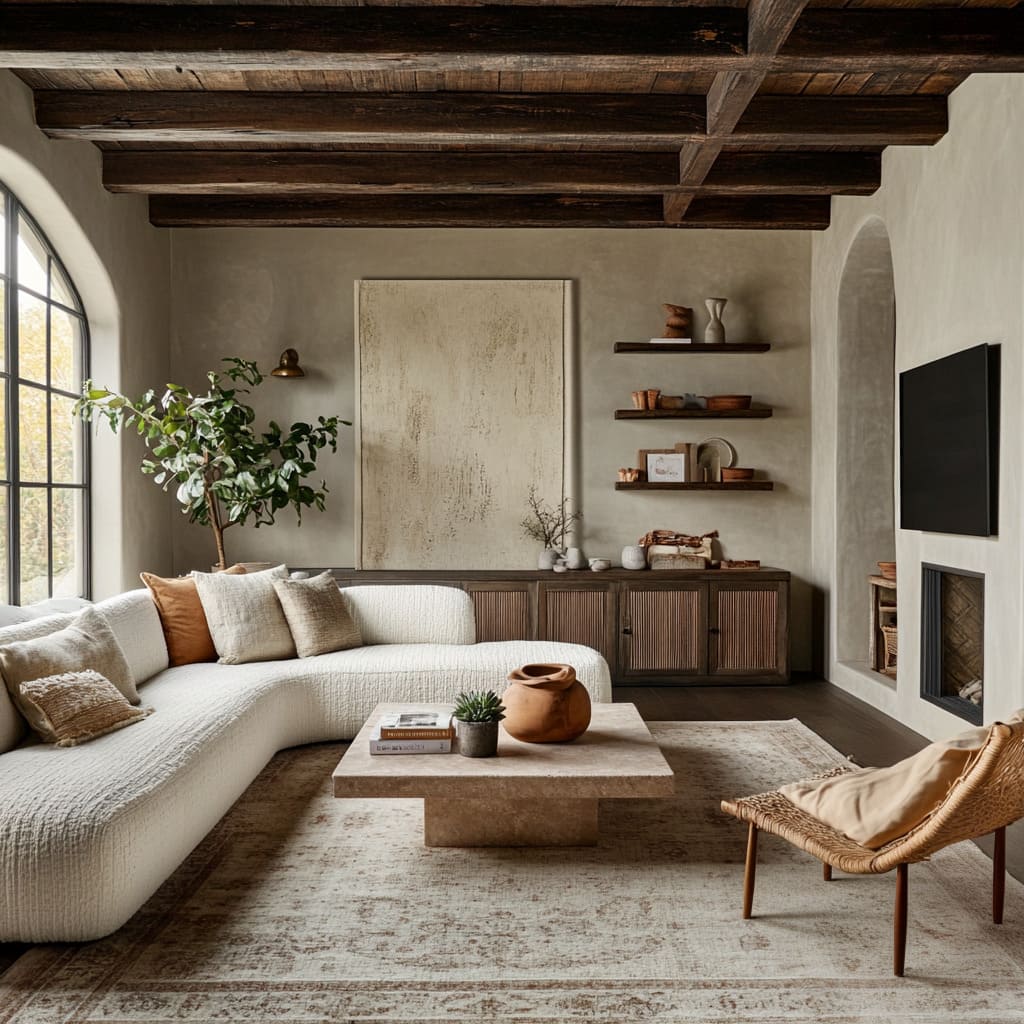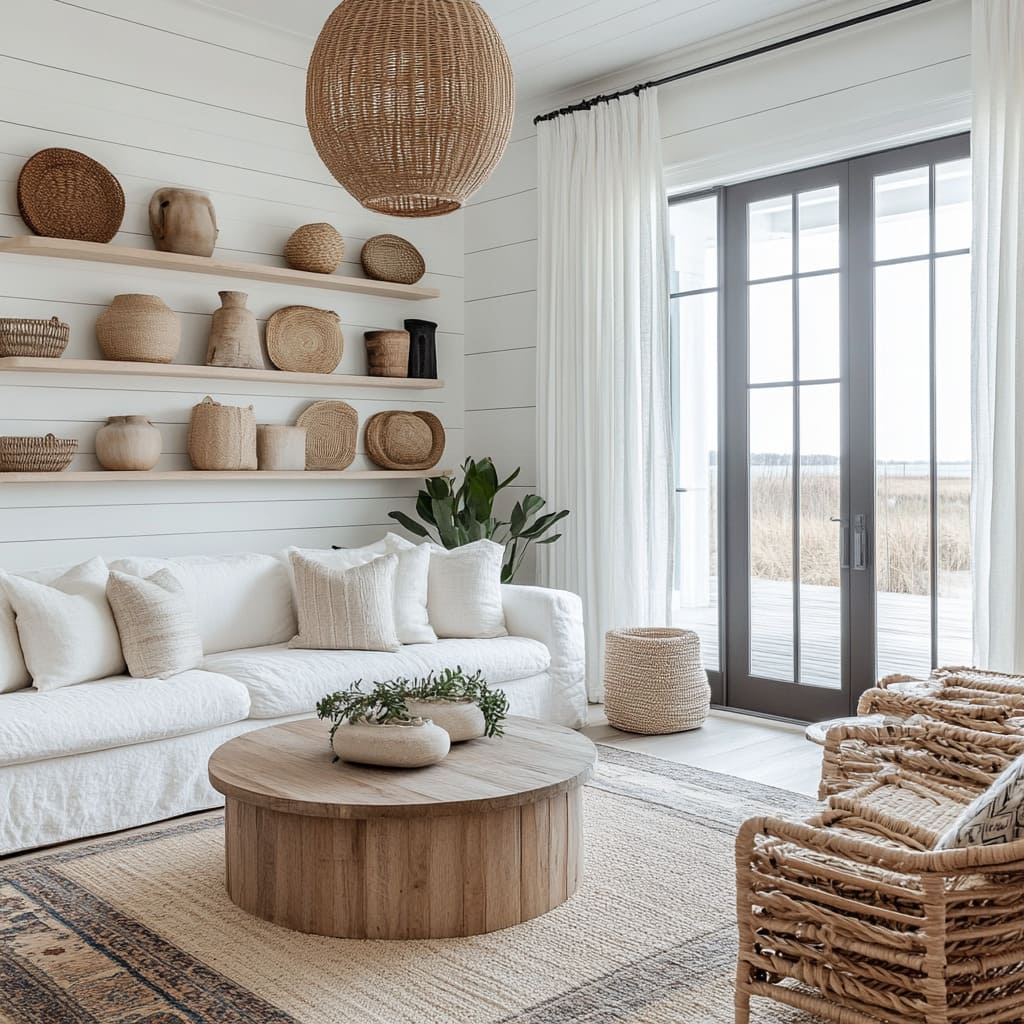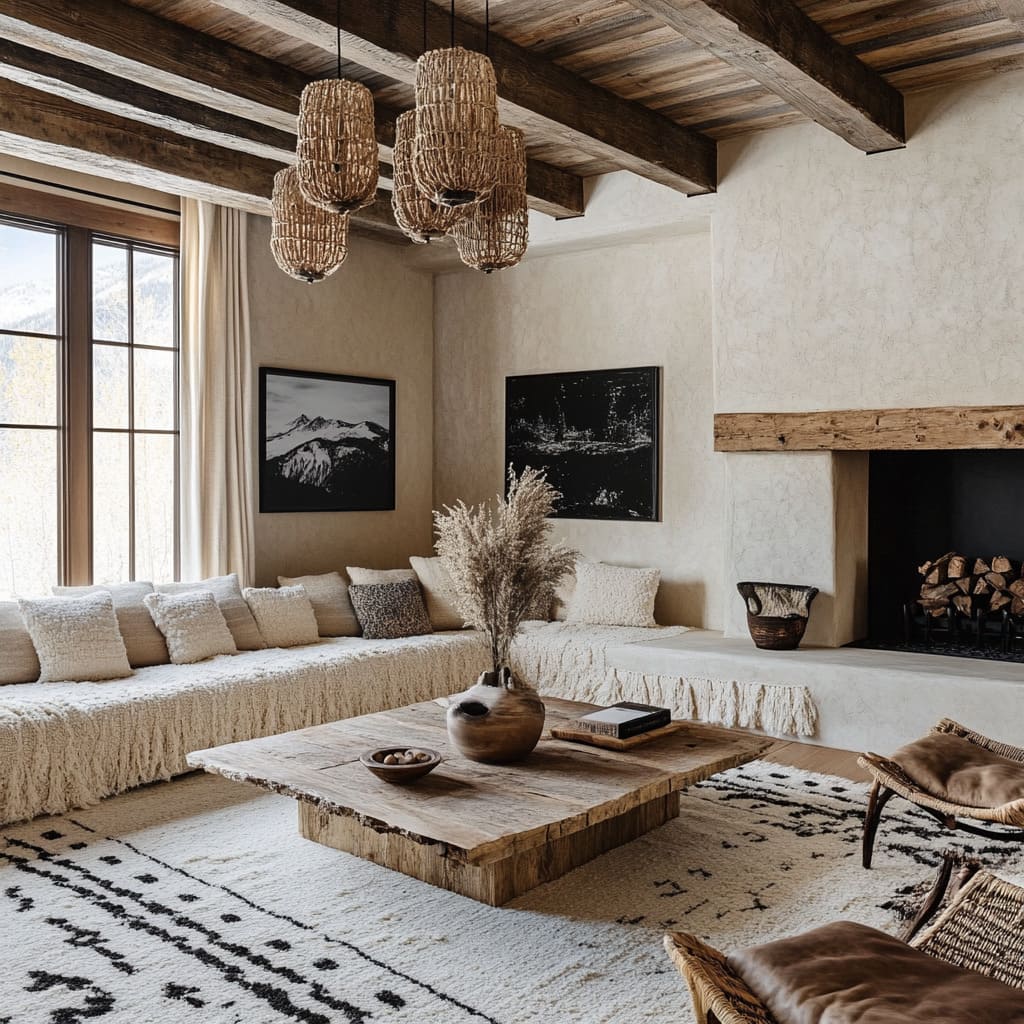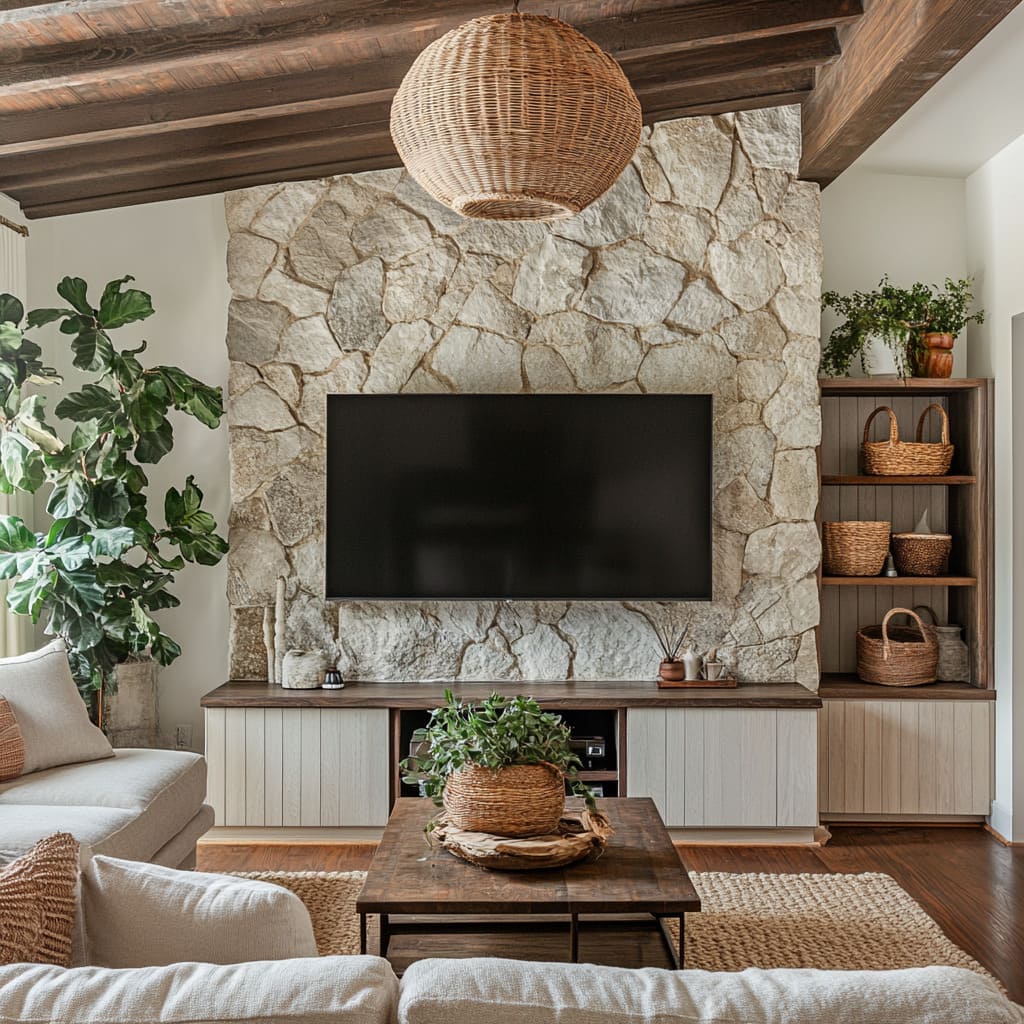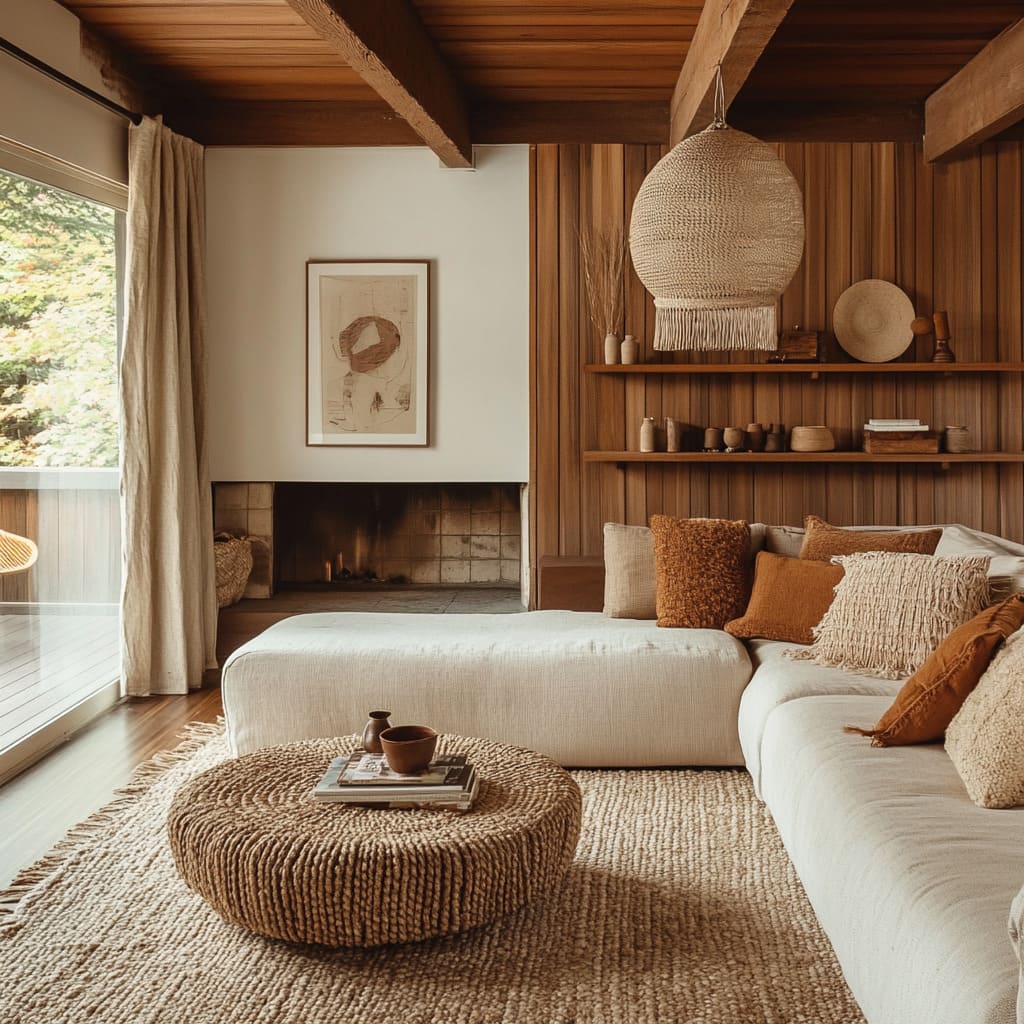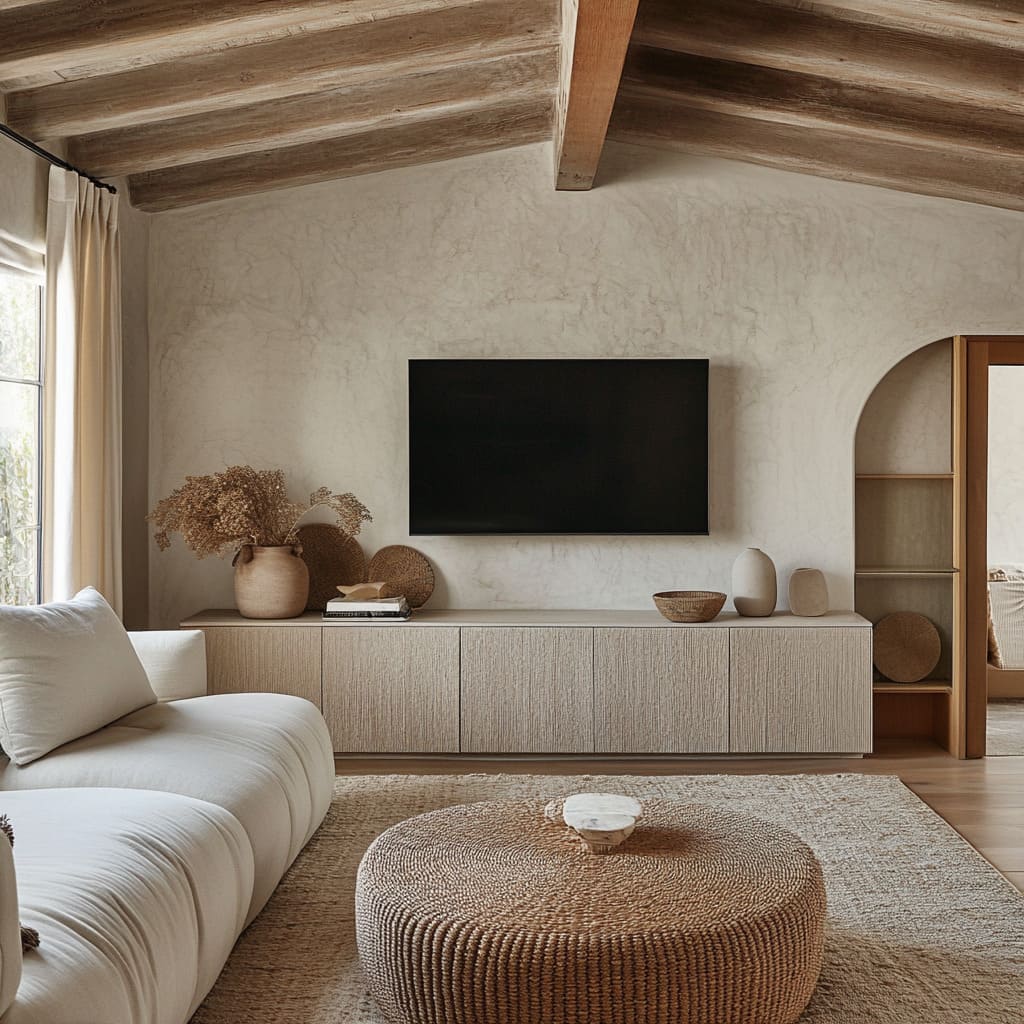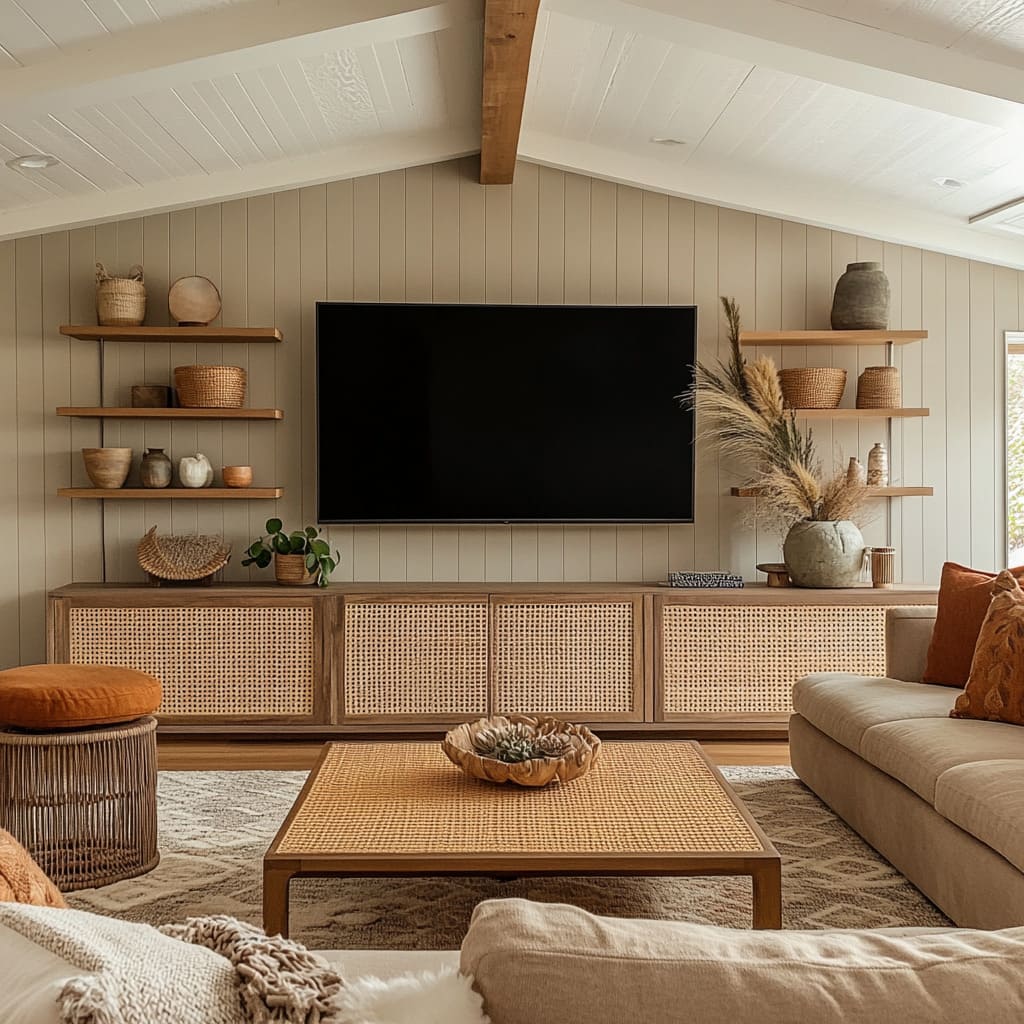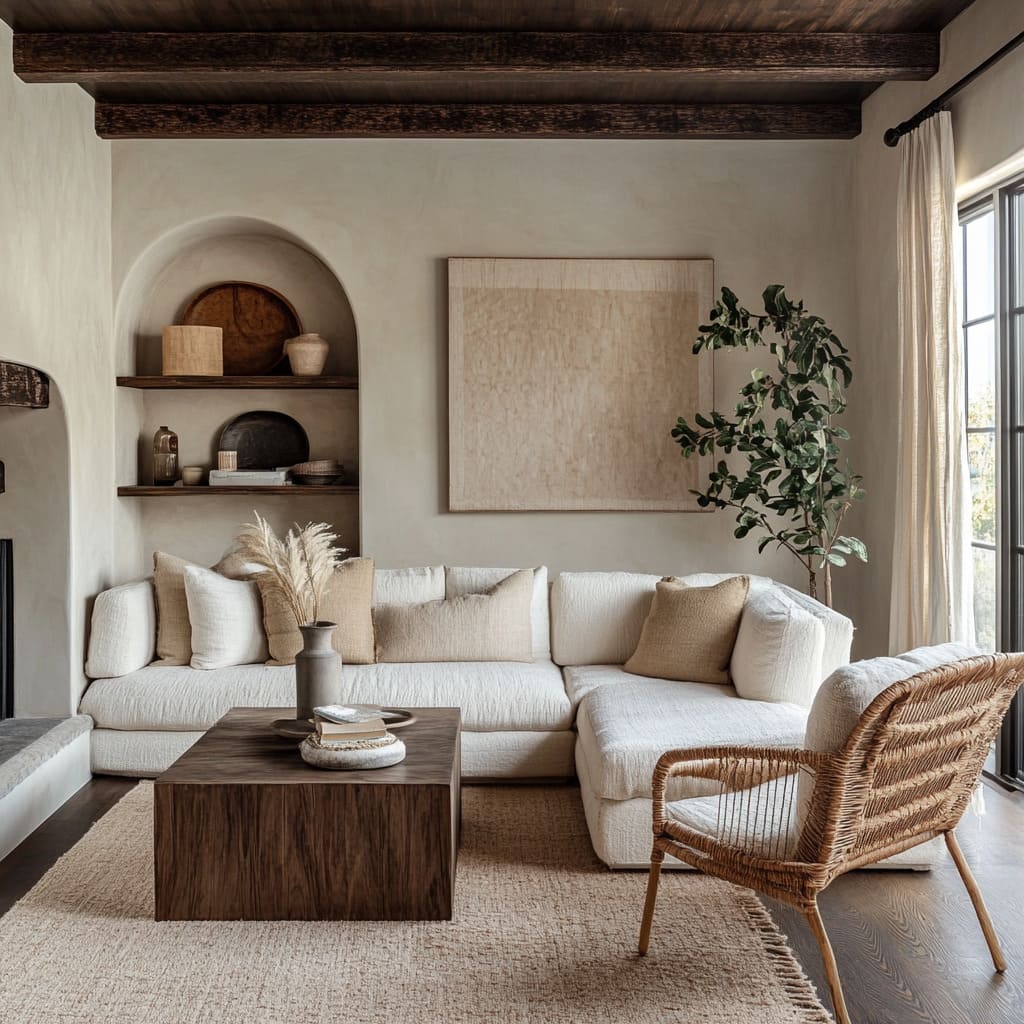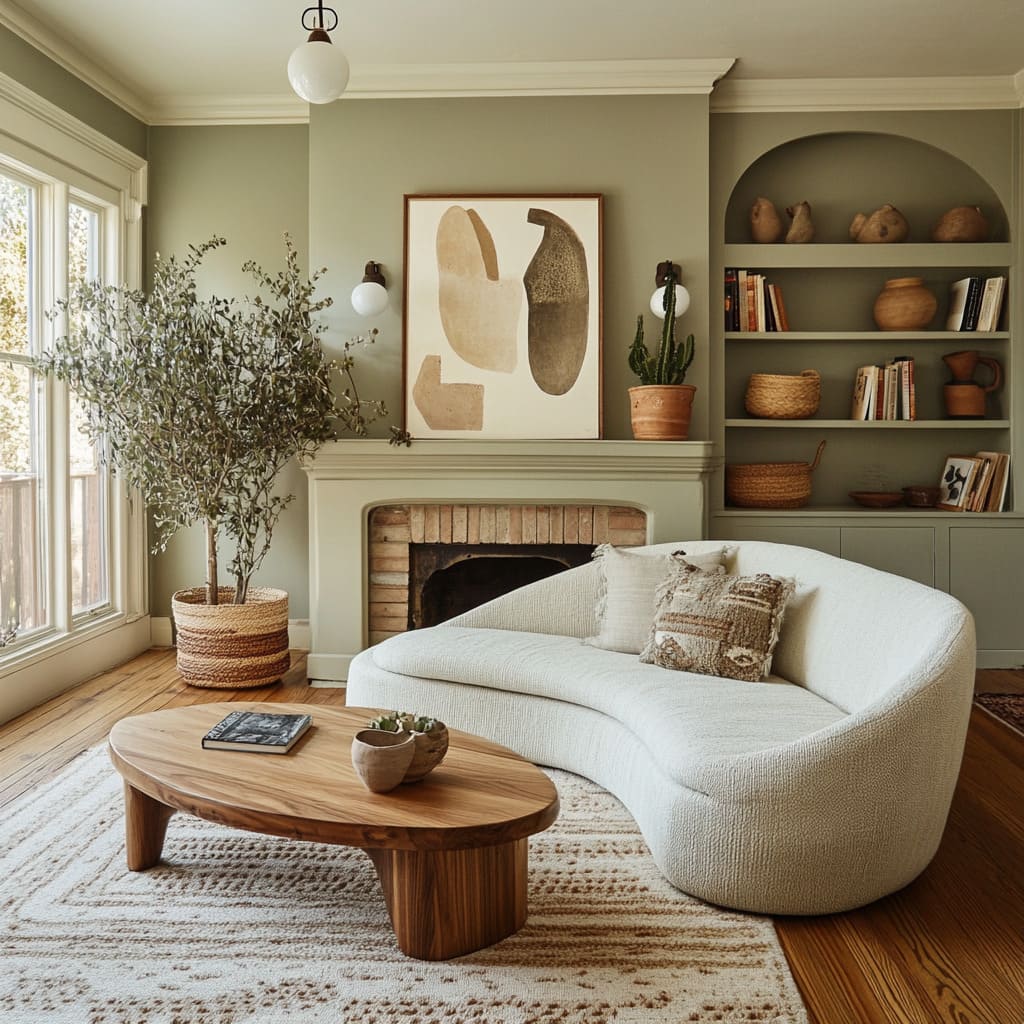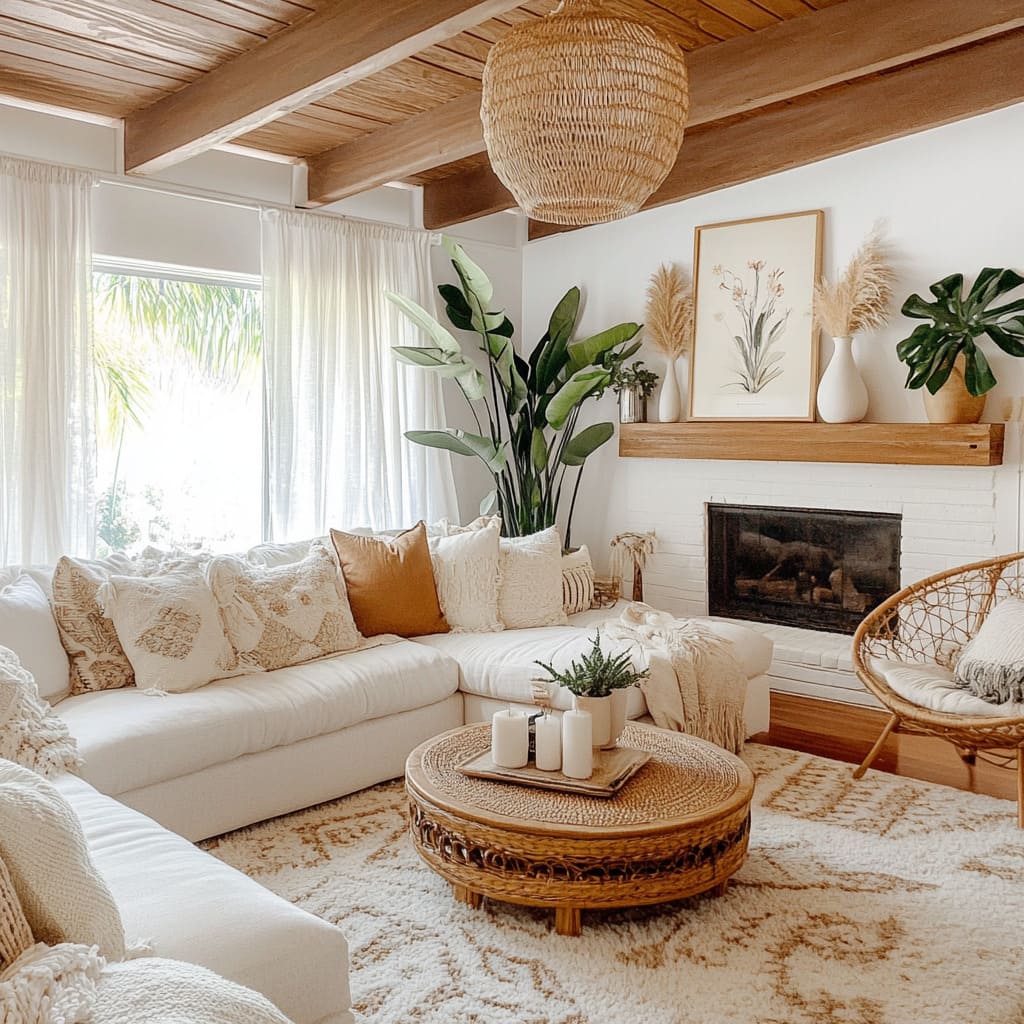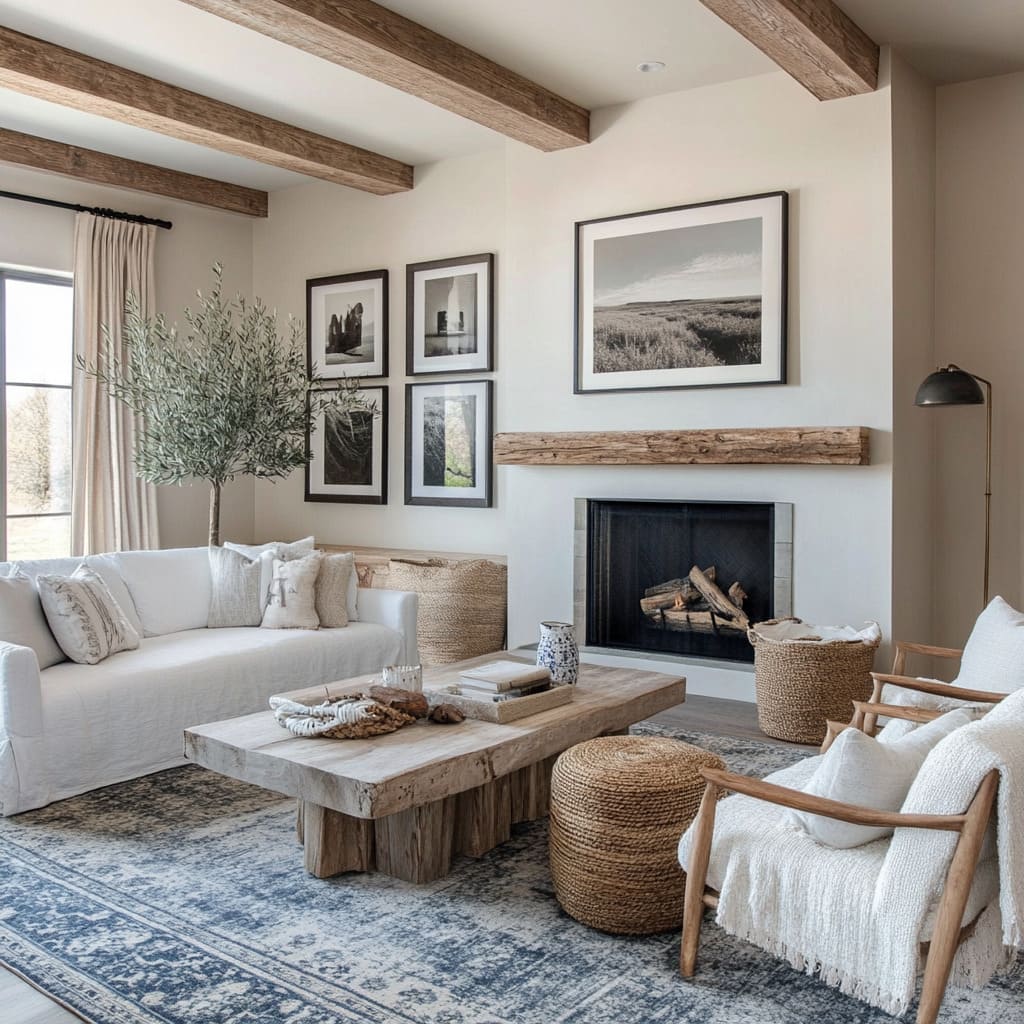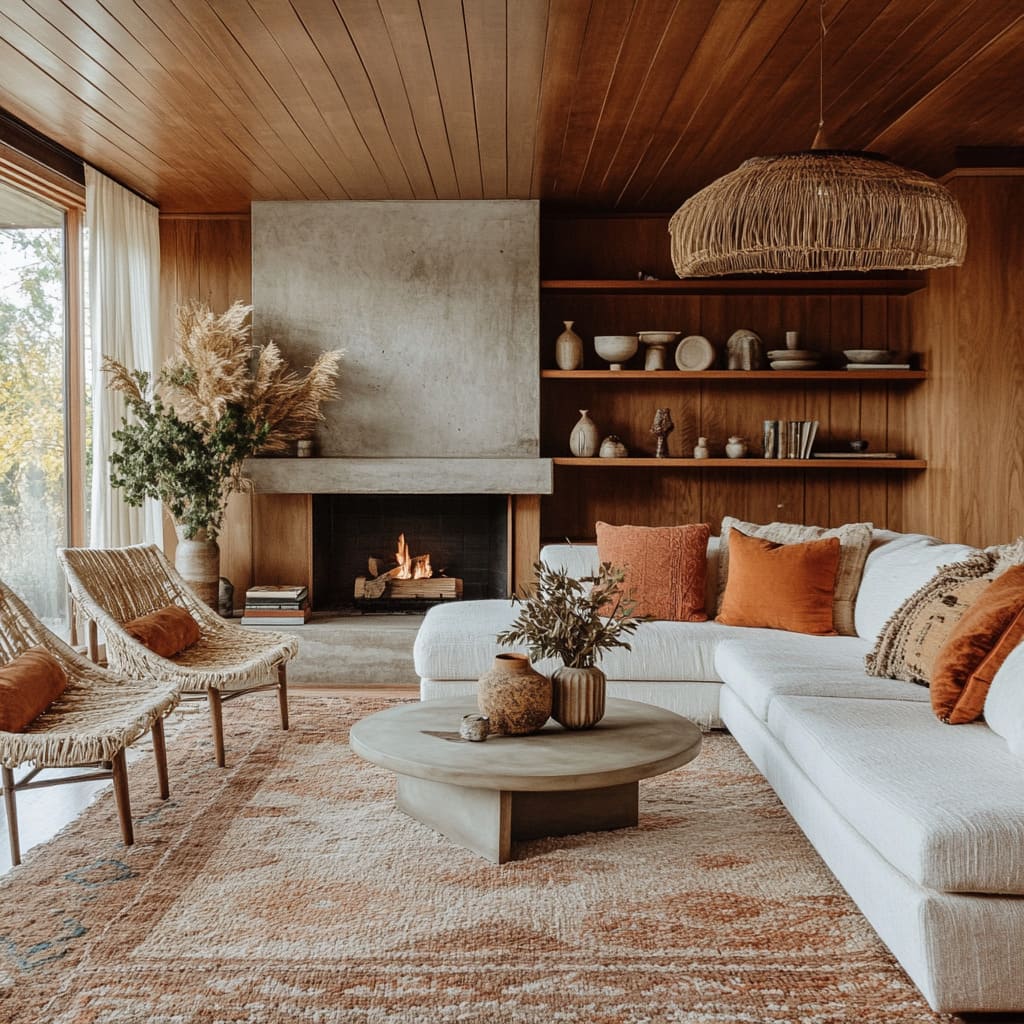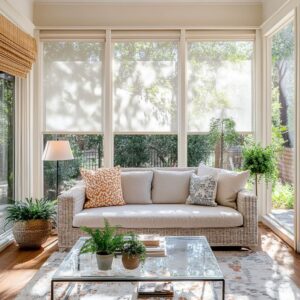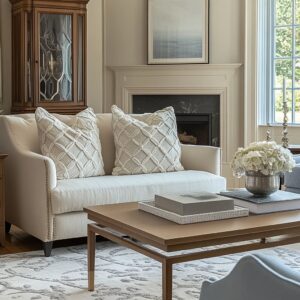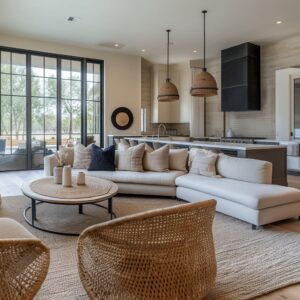A modern boho living room isn’t just about layering textures and adding a few woven accents—it’s about creating a space that feels relaxed, inviting, and effortlessly stylish. The best designs strike a balance between warmth and structure, blending natural materials with carefully curated decor to keep the room visually interesting without feeling cluttered.
What makes these spaces so appealing is their ability to mix softness with statement pieces. Earthy tones, raw wood, and organic textiles set the foundation, while thoughtful details like sculptural furniture, layered rugs, and curated shelving add depth.
Instead of relying on bold patterns or excessive color, modern boho interiors focus on muted contrasts, subtle repetition, and pieces that feel collected over time. This guide breaks down the key elements that bring these spaces to life, showing how small design choices—like the right lighting, a well-placed vintage rug, or the use of negative space—can completely change the feel of a room.
Whether starting fresh or making simple updates, these ideas will help you create a space that looks beautifully put together while remaining effortlessly livable.
Balance of Heavy and Light Elements
Creating a modern boho living room that feels both inviting and visually balanced means carefully playing with contrast. Many of the most inspiring modern boho living room ideas master the art of combining sturdy, grounded architectural features with softer, airier elements.
This balance prevents a space from feeling either too imposing or too weightless. Think about the structural elements already present—things like exposed wooden beams, a stone-clad fireplace, or a deep-toned accent wall.
These features bring character, but if left unbalanced, they can make a room feel overly heavy. The key is to introduce softer layers that create contrast without clashing.
A spacious, neutral-toned sectional can counteract the depth of darker wood paneling, keeping the room from feeling enclosed. Sheer, flowing curtains will lighten the visual weight of a bold fireplace, allowing natural light to soften the space.
Woven rattan pendant lights or textured linen lampshades can add a sense of airiness, preventing darker tones from overwhelming the design.
For homes with deep-colored walls—charcoal, terracotta, or rich walnut—bringing in natural textures is an effortless way to lift the atmosphere. A plush jute rug, a handwoven throw blanket, or an oversized light wood coffee table will create contrast and prevent the room from feeling too dense.
The right balance ensures a space that feels grounded yet breathable, warm yet open. Whether designing from scratch or refreshing an existing layout, blending these elements thoughtfully will create a room that feels intentional and inviting.
Textural Repetition Rather Than Random Mixing
A modern bohemian living room isn’t just about layering different materials—it’s about creating a rhythm with textures so the space feels thoughtfully put together rather than chaotic. While it might seem like boho design is all about free-spirited mixing, the most well-designed rooms rely on a careful balance of repetition.
Instead of throwing together every woven, rough, or plush surface available, the key is to choose a few standout textures and use them consistently across different elements in the room.
For example, if a space features a cane-front media console, that same woven cane texture might appear on cabinet doors, light fixtures, or even the seatbacks of dining chairs nearby. A rattan pendant light can be echoed in a rattan lounge chair or a woven basket planter, creating a sense of unity rather than visual overload.
Likewise, if jute is introduced as a rug material, carrying that same fiber into decorative trays, ottomans, or lampshades will reinforce continuity.
The beauty of this approach is that it keeps a space feeling organic while maintaining a sense of structure. Too many different weaves, fabrics, and rough-hewn surfaces in one space can make a room feel unsettled, whereas a carefully repeated pattern of materials makes everything flow.
If you want a space that feels both layered and refined, choose two or three primary textures—such as rattan, raw wood, and linen—and let them reappear in different forms throughout the room. This subtle repetition ensures the mix of elements feels collected rather than cluttered.
Muted Color Contrasts for Depth
Boho interiors are often linked with vibrant color, but modern spaces take a more refined approach. Instead of loud, saturated tones, the best designs lean into muted contrasts—think earthy rust, deep olive, and soft terracotta.
These shades still provide warmth and interest but in a way that feels grounded rather than overwhelming. By layering variations of a single color family, a room gains richness without the visual clutter of too many competing hues.
This approach works especially well in living spaces where textures take center stage. A soft clay-toned sofa might be paired with cushions in subtle variations of rust and tan, while a woven jute rug can sit beneath a deeper terracotta ottoman.
A ceramic vase in a smoky olive finish can complement the natural green of a potted plant nearby, reinforcing depth without stark contrast.
For a cohesive look, focus on a tight color palette rooted in “earth neutrals. ” Shades like oatmeal, warm sand, muted sage, and sienna blend seamlessly, creating a layered effect that feels intentional.
Instead of relying on a single bold accent color, use different intensities of the same hue throughout the space—through textiles, wall tones, pottery, and decor. This not only makes the room feel connected but also highlights the textures and natural materials that define boho interiors.
Soft Geometry in Furniture
The shape of furniture plays a bigger role in a room’s feel than many people realize. In a modern boho space, soft, rounded forms help balance out the sharper edges of built-ins, architectural lines, and structural details.
Instead of rigid, boxy silhouettes, many designs lean into curved sectionals, oval coffee tables, and arched shelving. These elements introduce a sense of movement and flow, making a space feel more relaxed and inviting.
If your room feels dominated by straight lines—whether from window frames, shelving, or ceiling beams—swapping in rounded pieces can make a noticeable difference. A curved sofa instantly shifts the energy of a seating area, breaking up harsh angles.
Even a small change, like replacing a square coffee table with a circular or oval one, can soften the overall look.
For those who love a DIY challenge, arched wall niches or softly curved built-ins can bring a custom feel to the space. If architectural updates aren’t an option, incorporating mirrors, headboards, or shelving with arched tops can create a similar effect.
Layering these shapes in different areas of the room keeps everything visually balanced. The best modern boho living room furniture isn’t just about texture and material—it’s about shape, too.
Rounded edges make a room feel effortless and welcoming, adding a natural rhythm that offsets harder structural elements. By weaving in these gentle curves through furniture and decor, you can create a space that feels both thoughtfully designed and comfortable.
Spotlight on Natural Botanicals and Dried Foliage
Bringing nature indoors is one of the most effortless ways to create a boho-inspired space, but it’s not just about placing a few random plants around the room. The choice of greenery—and how it’s arranged—has a big impact on the overall feel.
Pampas grass, olive trees, and large-leaf tropical plants like monstera or bird of paradise do more than just add color; their unique shapes and textures introduce movement, balance, and depth.
Dried botanicals, such as feathery pampas stems or wispy wheat stalks, soften sharp architectural lines and create a natural flow. Placing taller arrangements near a fireplace or in a corner helps draw the eye upward, making the space feel more open and inviting.
If the goal is to introduce a sense of vibrancy, large-leaf plants bring a more sculptural presence while still fitting into the relaxed aesthetic of boho interiors. For a balanced look, mix different heights and textures.
A woven basket planter with an olive tree can sit next to a rattan chair, while a small ceramic vase with dried florals can rest on a shelf. This layering makes the greenery feel like a natural part of the space rather than an afterthought.
Whether fresh or dried, botanicals complete the organic feel that defines boho interiors, adding warmth, contrast, and a sense of life.
Art That Merges with the Palette
Artwork in a modern bohemian living room isn’t meant to be the loudest element in the space—it’s there to complement the textures, colors, and natural materials already present. Instead of highly saturated or overly detailed pieces, the best designs incorporate muted abstract paintings, soft-toned botanical prints, or minimalist line drawings.
These choices add character without clashing with the layered textiles, woven accents, and warm wood tones that define the room’s aesthetic.
Keeping artwork within the same color range as the furniture and decor creates a cohesive look. A large canvas in warm beige and soft terracotta can echo the hues of throw pillows and ceramic vases, while a monochrome botanical print in a light oak frame will tie in seamlessly with floating wooden shelves.
The goal is to enhance the atmosphere rather than overwhelm it.
Framing also plays a subtle but important role. Light wood frames work well in rooms with natural shelving and mantels, while black or antique brass frames can add contrast without disrupting the softness of the space.
If the walls already have paneling or textured plaster, leaning a framed piece on a console or shelf instead of mounting it can keep the look casual and adaptable. By choosing art that blends with the palette rather than competing with it, the space feels connected and thoughtfully curated, allowing textures and organic elements to take center stage.
Importance of Layered Rugs and Varied Weaves
A well-designed boho space rarely relies on a single rug. Instead, layering different textures underfoot adds depth, warmth, and visual separation—especially in open-concept layouts.
Combining a thick, plush rug with a flatter woven one creates a balance of comfort and texture, making the room feel more grounded while maintaining a relaxed, effortless aesthetic. Layering rugs isn’t just about looks—it also serves a practical purpose.
A high-pile wool or shag rug defines the main seating area, providing softness underfoot, while a jute or vintage-patterned accent rug placed on top adds dimension and contrast. This approach helps highlight key furniture pieces, such as a coffee table or lounge chair, while making a space feel more intentionally styled.
For rooms with neutral flooring, a woven rug layered at an angle over a larger solid-colored base can break up the monotony and add interest without overwhelming the design. The trick is to keep the color palette cohesive while playing with different textures.
A handwoven Moroccan-style rug over a natural fiber base, for example, brings in a mix of softness and structure, enhancing the cozy yet layered look that defines modern boho interiors.
In open-concept spaces, this technique becomes even more useful, subtly marking different zones without the need for physical dividers. Whether used to anchor a seating area, create a cozy reading nook, or simply add a touch of warmth to bare floors, layered rugs help bring everything together while keeping the space visually engaging.
Thoughtful Shelf Curation
Open shelving in a boho-inspired space isn’t about filling every available inch—it’s about selecting pieces that feel meaningful, visually cohesive, and intentional. The best-styled shelves in boho modern living room ideas follow a curated approach, using negative space to highlight key decorative elements rather than overwhelming the display with too much clutter.
Instead of cramming shelves with random objects, successful designs focus on balance. A few well-placed ceramics, woven baskets, and stacked books create a relaxed yet polished look.
Items tend to be grouped by tone or material rather than scattered randomly. For instance, matte off-white vases in different shapes but similar finishes will look cohesive when arranged together, while a mix of wood, rattan, and linen-textured objects helps maintain a natural and effortless aesthetic.
One of the best ways to style shelves without making them feel empty is to vary heights and shapes. A taller sculptural vase can sit next to a smaller stacked book arrangement, while a wide ceramic bowl balances out narrower vertical objects.
This variation adds movement to the display without making it feel cluttered. For those who love a more organic look, placing decorative items in small clusters rather than lining them up in rows keeps the arrangement interesting.
Leaving intentional gaps between groups allows each piece to stand out, making the display feel layered rather than chaotic. Whether styling built-ins or floating shelves, thoughtful curation ensures that every piece feels like part of a well-designed composition rather than just another item taking up space.
Subtle Repetition of Tones and Materials Across the Room
A well-designed space feels effortlessly cohesive, but that harmony doesn’t happen by accident. It’s often the result of repeating materials, finishes, and colors in a way that connects different elements of the room without making them feel overly matched.
The best interiors use this technique subtly—you might not immediately notice why everything looks polished, but the repetition of details ties the space together.
One common approach is mirroring wood tones throughout the room. If there are exposed dark beams overhead, incorporating that same wood finish in a side table, picture frame, or open shelving creates an understated connection.
A mantelpiece in the same stain as a coffee table will reinforce continuity without making the design feel forced.
This idea extends beyond wood. A rattan accent chair can feel even more intentional when paired with a woven light fixture or a cane-front media console.
Even softer elements, like textiles, can follow this principle—an earthy rust-colored throw pillow might be reflected in a vintage rug or ceramic vase across the room. By repeating tones and materials in different areas, the design gains a sense of rhythm.
The space feels thoughtfully layered rather than a mix of separate pieces. The key is subtlety—just enough repetition to create flow while keeping the room dynamic and visually engaging.
Inclusion of a Subtle Global or Vintage Element
A space that feels too new or overly curated can sometimes lack warmth. That’s where vintage and globally inspired elements come in—they add character, depth, and a sense of history to a room.
Even in modern interiors, a single well-chosen piece with a bit of patina can make a space feel layered and lived-in rather than straight out of a catalog. One of the easiest ways to bring in this depth is through textiles.
A vintage rug, even if slightly faded, introduces a timeless quality that grounds the space. Whether it’s a handwoven Moroccan-style rug or a well-worn Persian runner, these pieces tell a story through their textures and patterns.
If a full rug isn’t an option, smaller touches like woven wall hangings or embroidered throw pillows can have a similar effect.
Furniture is another way to weave in a sense of history. A secondhand wooden console with visible grain, an antique side table with slightly imperfect edges, or a reclaimed wood coffee table instantly adds warmth without overwhelming the overall design.
The trick is to mix these older finds with modern elements, so the space feels collected over time rather than styled all at once.
For a subtle global influence, look for decorative objects that bring a handcrafted feel without introducing loud colors that might compete with the rest of the design. A set of neutral-toned ceramic vases, a carved wooden bowl, or woven baskets from different regions can all add personality while staying within a cohesive palette.
The goal isn’t to make the room feel themed—it’s about incorporating pieces that have a sense of craftsmanship and authenticity. By blending these elements naturally, a space gains depth and richness without feeling cluttered.
Whether through a single vintage rug, an aged wood console, or carefully chosen ceramics, these pieces bring warmth and a sense of individuality to any boho-inspired home.
How to Adapt These Ideas at Home
Bringing a boho-inspired space to life doesn’t require a complete redesign—it’s about layering natural textures, balancing materials, and keeping the atmosphere relaxed yet intentional. Whether you’re starting from scratch or refining an existing space, a few key choices can make all the difference.
Begin with a foundation of light neutrals. Soft white or cream walls, paired with a neutral sofa, create a backdrop that allows textures and materials to stand out.
This approach keeps the room feeling open and lets accent pieces shine without overwhelming the space.
To add depth, choose one bold statement fixture that serves as a focal point. It could be a plaster fireplace surround, a dark wood-paneled TV wall, or an oversized woven light fixture.
A single striking element helps anchor the design and makes the room feel cohesive. Material selection plays a major role in a modern boho aesthetic.
Instead of mixing too many finishes, focus on two or three key materials—such as cane, raw wood, and handcrafted ceramics. Repeating these elements across shelving, furniture, and decor will naturally tie everything together.
For softness and warmth, layer throw pillows and blankets in earthy shades like rust, tan, sage, or terracotta. Keep patterns minimal and stick to subtle variations within the same color family to maintain harmony.
Lighting is another defining feature of boho interiors. Woven pendants or softly diffused lighting create warmth and ambiance, while a group of smaller pendant lights or wall sconces can add a more layered effect.
Greenery is essential, whether in the form of dried pampas grass, a potted olive tree, or cascading vines. Natural elements breathe life into the space and enhance the organic feel of the design.
When it comes to decor, less is more. Instead of filling shelves with random pieces, select a few objects that hold meaning—perhaps a handcrafted bowl, a sculptural vase, or a framed piece of minimalist art.
Intentional choices will keep the space from feeling cluttered while still maintaining personality.
Finally, artwork should blend with the room’s palette rather than compete with it. Abstract paintings in muted tones or simple line drawings will allow textures and materials to remain the focus.
By following these principles, you can create a space that feels natural, inviting, and visually balanced without sacrificing comfort or style.
Final Thoughts
What makes modern boho living rooms so inviting is the way they balance comfort with thoughtful design. These spaces never feel overdone or chaotic, yet every detail contributes to a sense of warmth and personality.
It’s the careful mix of textures, organic materials, and layered tones that gives them their distinctive charm. Rather than relying on excessive decor, these interiors let raw finishes, handcrafted objects, and soft, natural palettes do the work.
The result is a space that feels welcoming without being overwhelming. The key takeaway?
Focus on balance. Pair structured architectural elements with soft curves, introduce natural light wherever possible, and be intentional with decorative choices.
By applying these ideas to your own space, you can create a living room that feels both visually engaging and deeply personal. Whether through a well-placed vintage rug, a sculptural coffee table, or a carefully curated shelf, every detail should feel connected to the larger design.
The goal is a space that looks effortlessly put together—one that feels as good to be in as it does to look at.
